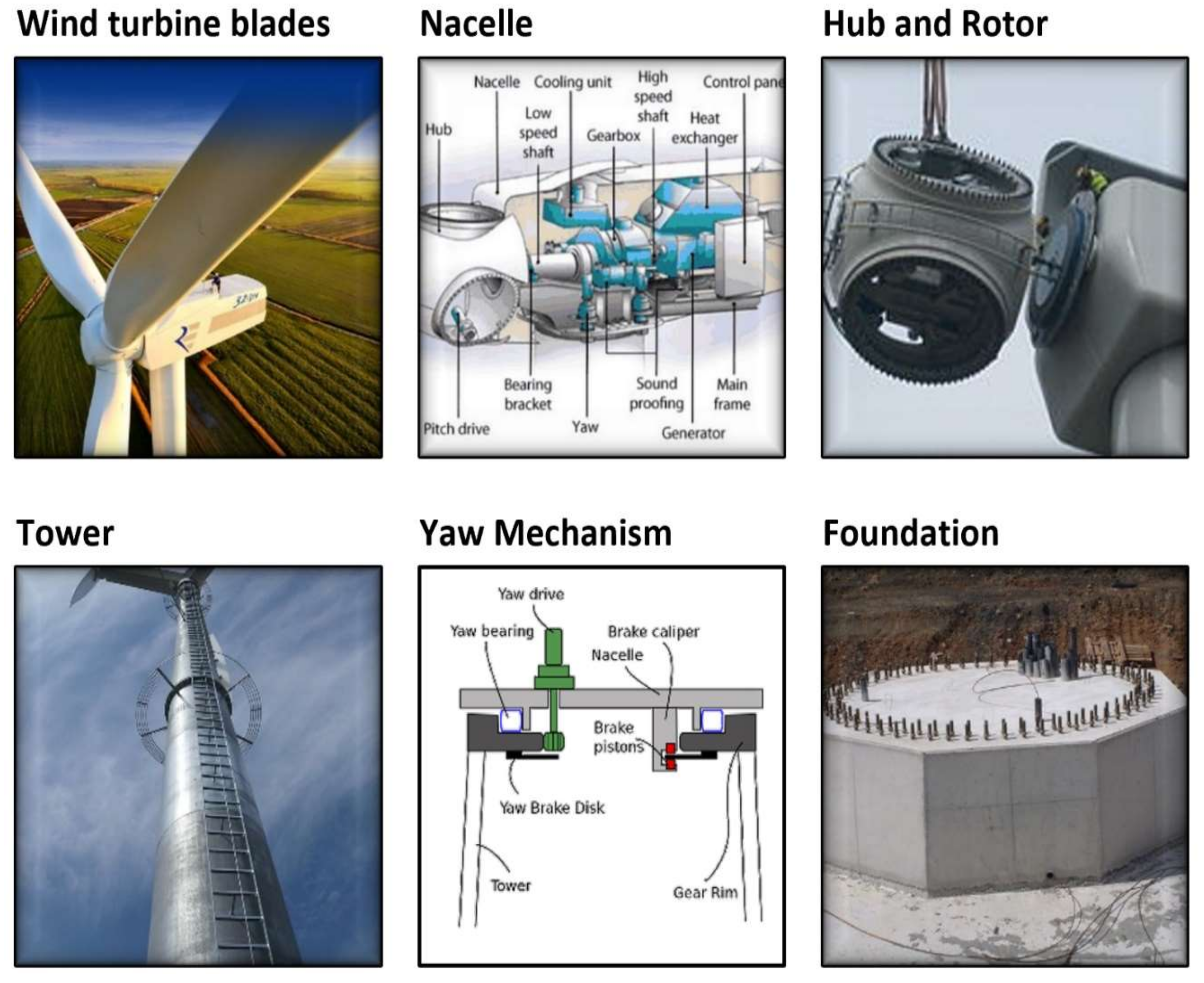Selection Guidelines for Wind Energy Technologies
Abstract
1. Introduction
2. Wind Energy
- ⮚
- The sun unevenly heating the atmosphere.
- ⮚
- Air pressure variation from one region to another.
- ⮚
- Irregularities of the earth’s surface, i.e., topology.
- ⮚
- The rotation of the earth.
2.1. Wind Resource Assessment
2.2. Modeling of Wind Resource
3. Wind Energy Technologies
3.1. Types of Wind Turbine
3.2. Horizontal Axis Wind Turbine
3.3. Vertical Axis Wind Turbine
3.3.1. Savonius Vertical Axis Wind Turbine
3.3.2. Darrieus Vertical Axis Wind Turbine
4. Design of the Wind Turbine System
4.1. The Drivetrain
4.2. Wind Turbine Blades
4.3. Wind Aerodynamic Model
4.4. Wind Energy Conversion Systems
4.5. Generator for Wind Energy Conversion Systems
4.5.1. Asynchronous Generators
4.5.2. Synchronous Generators
4.6. Power Electronics
5. Selection Guidelines for Wind Energy Technologies
6. Technological Advancement in Wind Energy
6.1. Wind Turbine Blades
6.1.1. State-of-the-Art Wind Turbine Blade Development
6.1.2. Future Research Activities for Wind Turbine Blades
6.2. Towers and Foundation
6.3. Energy Storage Systems
7. Conclusions
- 1-
- If the site accepts wind speed from one direction, then the horizontal-axis wind turbine HAWT is the best turbine type, while the vertical-axis wind turbine VAWT is the best turbine type for a site accepting wind from all directions.
- 2-
- In addition to the VAWT accepting the wind from all directions on-site, its wind speed level and speed of rotation are less than those of HAWT.
- 3-
- The selection of a generator type for both HAWT and VAWT is based on the condition of wind speed as follows:
- (a)
- If the wind speed level is fixed, then the squirrel cage induction generator (SCIG) is the best generator selection.
- (b)
- If the wind speed level varies narrowly or widely, then there are many options for generator selection, such as a squirrel cage, wound rotor (WR) with external resistance, or partial or full-power electronics, such as a double-fed induction generator DFIG, synchronous generator, or permanent magnet synchronous generator (PMSG).
Author Contributions
Funding
Institutional Review Board Statement
Informed Consent Statement
Data Availability Statement
Conflicts of Interest
References
- Zhang, Z.; Borhani, T.N.; Olabi, A.G. Status and perspective of CO2 absorption process. Energy 2020, 205, 118057. [Google Scholar] [CrossRef]
- Wilberforce, T.; Olabi, A.G.; Sayed, E.T.; Elsaid, K.; Abdelkareem, M.A. Progress in carbon capture technologies. Sci. Total Environ. 2020. [Google Scholar] [CrossRef]
- Fant, C.; Boehlert, B.; Strzepek, K.; Larsen, P.; White, A.; Gulati, S.; Li, Y.; Martinich, J. Climate change impacts and costs to U.S. electricity transmission and distribution infrastructure. Energy 2020, 195, 116899. [Google Scholar] [CrossRef]
- Kabayo, J.; Marques, P.; Garcia, R.; Freire, F. Life-cycle sustainability assessment of key electricity generation systems in Portugal. Energy 2019, 176, 131–142. [Google Scholar] [CrossRef]
- Hanif, I.; Raza, S.M.F.; Gago-de-Santos, P.; Abbas, Q. Fossil fuels, foreign direct investment, and economic growth have triggered CO2 emissions in emerging Asian economies: Some empirical evidence. Energy 2019, 171, 493–501. [Google Scholar] [CrossRef]
- Al-Shayji, K.; Aleisa, E. Characterizing the fossil fuel impacts in water desalination plants in Kuwait: A Life Cycle Assessment approach. Energy 2018, 158, 681–692. [Google Scholar] [CrossRef]
- Salameh, T.; Abdelkareem, M.A.; Olabi, A.G.; Sayed, E.T.; Al-Chaderchi, M.; Rezk, H. Integrated standalone hybrid solar PV, fuel cell and diesel generator power system for battery or supercapacitor storage systems in Khorfakkan, United Arab Emirates. Int. J. Hydrogen Energy 2020, 46, 6014–6027. [Google Scholar] [CrossRef]
- Olabi, A.G.; Bahri, A.s.; Abdelghafar, A.A.; Baroutaji, A.; Sayed, E.T.; Alami, A.H.; Rezk, H.; Abdelkareem, M.A. Large-scale hydrogen production and storage technologies: Current status and future directions. Int. J. Hydrogen Energy 2020. [Google Scholar] [CrossRef]
- Elsaid, K.; Sayed, E.T.; Yousef, B.A.A.; Rabaia, M.K.H.; Abdelkareem, M.A.; Olabi, A.G. Recent progress on the utilization of waste heat for desalination: A review. Energy Convers. Manag. 2020, 221, 113105. [Google Scholar] [CrossRef]
- Olabi, A.G.; Elsaid, K.; Rabaia, M.K.H.; Askalany, A.A.; Abdelkareem, M.A. Waste heat-driven desalination systems: Perspective. Energy 2020, 209, 118373. [Google Scholar] [CrossRef]
- Jouhara, H.; Olabi, A.G. Editorial: Industrial waste heat recovery. Energy 2018, 160, 1–2. [Google Scholar] [CrossRef]
- Cherif, H.; Benakcha, A.; Laib, I.; Chehaidia, S.E.; Menacer, A.; Soudan, B.; Olabi, A.G. Early detection and localization of stator inter-turn faults based on discrete wavelet energy ratio and neural networks in induction motor. Energy 2020, 212, 118684. [Google Scholar] [CrossRef]
- Abdelkareem, M.A.; Elsaid, K.; Wilberforce, T.; Kamil, M.; Sayed, E.T.; Olabi, A. Environmental aspects of fuel cells: A review. Sci. Total Environ. 2021, 752, 141803. [Google Scholar] [CrossRef]
- Fathy, A.; Elaziz, M.A.; Sayed, E.T.; Olabi, A.G.; Rezk, H. Optimal parameter identification of triple-junction photovoltaic panel based on enhanced moth search algorithm. Energy 2019, 188, 116025. [Google Scholar] [CrossRef]
- Tanveer, W.H.; Rezk, H.; Nassef, A.; Abdelkareem, M.A.; Kolosz, B.; Karuppasamy, K.; Aslam, J.; Gilani, S.O. Improving fuel cell performance via optimal parameters identification through fuzzy logic based-modeling and optimization. Energy 2020, 204, 117976. [Google Scholar] [CrossRef]
- Alami, A.H.; Abdelkareem, M.A.; Faraj, M.; Aokal, K.; Al Safarini, N. Titanium dioxide-coated nickel foam photoelectrodes for direct urea fuel cell applications. Energy 2020, 208, 118253. [Google Scholar] [CrossRef]
- Longa, F.D.; Nogueira, L.P.; Limberger, J.; Wees, J.-D.V.; van der Zwaan, B. Scenarios for geothermal energy deployment in Europe. Energy 2020, 206, 118060. [Google Scholar] [CrossRef]
- Liang, J.-D.; Huang, B.-H.; Chiang, Y.-C.; Chen, S.-L. Experimental investigation of a liquid desiccant dehumidification system integrated with shallow geothermal energy. Energy 2020, 191, 116452. [Google Scholar] [CrossRef]
- Da Silva, R.G.; Ribeiro, M.H.D.M.; Moreno, S.R.; Mariani, V.C.; Coelho, L.D.S. A novel decomposition-ensemble learning framework for multi-step ahead wind energy forecasting. Energy 2020, 216, 119174. [Google Scholar] [CrossRef]
- Siddique, M.B.; Thakur, J. Assessment of curtailed wind energy potential for off-grid applications through mobile battery storage. Energy 2020, 201, 117601. [Google Scholar] [CrossRef]
- Sayed, E.T.; Alawadhi, H.; Elsaid, K.; Olabi, A.G.; Almakrani, M.A.; Tamim, S.B.; Alafranji, G.; Abdelkareem, M. A Carbon-Cloth Anode Electroplated with Iron Nanostructure for Microbial Fuel Cell Operated with Real Wastewater. Sustainability 2020, 12, 6538. [Google Scholar] [CrossRef]
- Rodriguez, C.; Alaswad, A.; El-Hassan, Z.; Olabi, A.G. Waste paper and macroalgae co-digestion effect on methane production. Energy 2018, 154, 119–125. [Google Scholar] [CrossRef]
- Wilberforce, T.; El Hassan, Z.; Durrant, A.; Thompson, J.; Soudan, B.; Olabi, A.G. Overview of ocean power technology. Energy 2019, 175, 165–181. [Google Scholar] [CrossRef]
- Soudan, B. Community-scale baseload generation from marine energy. Energy 2019, 189, 116134. [Google Scholar] [CrossRef]
- Ogungbemi, E.; Ijaodola, O.; Khatib, F.; Wilberforce, T.; El Hassan, Z.; Thompson, J.; Ramadan, M.; Olabi, A. Fuel cell membranes–Pros and cons. Energy 2019, 172, 155–172. [Google Scholar] [CrossRef]
- Zhang, L.; Fu, G.; Zhang, Z. Electricity generation and microbial community in long-running microbial fuel cell for high-salinity mustard tuber wastewater treatment. Bioelectrochemistry 2019, 126, 20–28. [Google Scholar] [CrossRef] [PubMed]
- IEA. Data and Statistics. Available online: https://www.iea.org/data-and-statistics?country=WORLD&fuel=CO2%20emissions&indicator=CO2BySource (accessed on 3 March 2021).
- Rabaia, M.K.H.; Abdelkareem, M.A.; Sayed, E.T.; Elsaid, K.; Chae, K.-J.; Wilberforce, T.; Olabi, A.G. Environmental impacts of solar energy systems: A review. Sci. Total Environ. 2020, 754, 141989. [Google Scholar] [CrossRef]
- Abdelkareem, M.A.; Assad, M.E.H.; Sayed, E.T.; Soudan, B. Recent progress in the use of renewable energy sources to power water desalination plants. Desalination 2018, 435, 97–113. [Google Scholar] [CrossRef]
- Shahbaz, M.; Raghutla, C.; Chittedi, K.R.; Jiao, Z.; Vo, X.V. The effect of renewable energy consumption on economic growth: Evidence from the renewable energy country attractive index. Energy 2020, 207, 118162. [Google Scholar] [CrossRef]
- Olabi, A.G.; Wilberforce, T.; Abdelkareem, M.A. Fuel cell application in the automotive industry and future perspective. Energy 2021, 214, 118955. [Google Scholar] [CrossRef]
- Størset, S.Ø.; Tangen, G.; Berstad, D.; Eliasson, P.; Hoff, K.A.; Langørgen, Ø.; Munkejord, S.T.; Roussanaly, S.; Torsæter, M. Profiting from CCS innovations: A study to measure potential value creation from CCS research and development. Int. J. Greenh. Gas Control. 2019, 83, 208–215. [Google Scholar] [CrossRef]
- Shaner, M.R.; Davis, S.J.; Lewis, N.S.; Caldeira, K. Geophysical constraints on the reliability of solar and wind power in the United States. Energy Environ. Sci. 2018, 11, 914–925. [Google Scholar] [CrossRef]
- Das, S.; Ghangrekar, M. Tungsten oxide as electrocatalyst for improved power generation and wastewater treatment in microbial fuel cell. Environ. Technol. 2019, 41, 2546–2553. [Google Scholar] [CrossRef] [PubMed]
- IRENA. Global Renewables Outlook: Energy Transformation 2050. Available online: https://www.irena.org/publications/2020/Apr/Global-Renewables-Outlook-2020 (accessed on 2 February 2021).
- Bilgili, M.; Yasar, A.; Simsek, E. Offshore wind power development in Europe and its comparison with onshore counterpart. Renew. Sustain. Energy Rev. 2011, 15, 905–915. [Google Scholar] [CrossRef]
- Koçak, K. A method for determination of wind speed persistence and its application. Energy 2002, 27, 967–973. [Google Scholar] [CrossRef]
- Wood, D. Determination of the optimum tower height for a small wind turbine. Int. J. Renew. Energy Eng. 2001, 3, 356–359. [Google Scholar]
- Green Building. Available online: https://www.greenspec.co.uk/building-design/small-wind-turbines/ (accessed on 2 November 2020).
- Weisser, D. A wind energy analysis of Grenada: An estimation using the ‘Weibull’density function. Renew. Energy 2003, 28, 1803–1812. [Google Scholar] [CrossRef]
- Panda, R.; Sarkar, T.; Bhattacharya, A. Stochastic study of the wind-energy potential of India. Energy 1990, 15, 921–930. [Google Scholar] [CrossRef]
- Lambert, M.; Ogle, M.; Smith, B. Investigation of wind-induced fatigue in tall guyed steel masts. J. Wind Eng. Ind. Aerodyn. 1988, 30, 55–65. [Google Scholar] [CrossRef]
- Karaki, S.H.; Salim, B.A.; Chedid, R.B. Probabilistic model of a two-site wind energy conversion system. IEEE Trans. Energy Convers. 2002, 17, 530–536. [Google Scholar] [CrossRef]
- Jamil, M.; Parsa, S.; Majidi, M. Wind power statistics and an evaluation of wind energy density. Renew. Energy 1995, 6, 623–628. [Google Scholar] [CrossRef]
- Şen, Z.; Şahin, A.D. Regional assessment of wind power in western Turkey by the cumulative semivariogram method. Renew. Energy 1997, 12, 169–177. [Google Scholar] [CrossRef]
- Ettoumi, F.Y.; Sauvageot, H.; Adane, A.-E.-H. Statistical bivariate modelling of wind using first-order Markov chain and Weibull distribution. Renew. Energy 2003, 28, 1787–1802. [Google Scholar] [CrossRef]
- Torre, M.; Poggi, P.; Louche, A. Markovian model for studying wind speed time series in Corsica. Int. J. Renew. Energy Eng. 2001, 3, 311–319. [Google Scholar]
- Feijoo, A.E.; Cidras, J.; Dornelas, J.G. Wind speed simulation in wind farms for steady-state security assessment of electrical power systems. IEEE Trans. Energy Convers. 1999, 14, 1582–1588. [Google Scholar] [CrossRef]
- Ulgen, K.; Genc, A.; Hepbasli, A.; Oturanc, G. Assessment of wind characteristics for energy generation. Energy Sources 2004, 26, 1227–1237. [Google Scholar] [CrossRef]
- Emeis, S. Measurement of the available wind energy with sodar. Indian J. Power River Val. Dev. 2001, 51, 244–250. [Google Scholar]
- Yesilbudak, M.; Sagiroglu, S.; Colak, I. A wind speed forecasting approach based on 2-dimensional input space. In Proceedings of the 2012 International Conference on Renewable Energy Research and Applications (ICRERA), Nagasaki, Japan, 11–14 November 2012; IEEE: Piscataway Township, NJ, USA, 2012; pp. 1–5. [Google Scholar]
- Kumar, Y.; Ringenberg, J.; Depuru, S.S.; Devabhaktuni, V.K.; Lee, J.W.; Nikolaidis, E.; Andersen, B.; Afjeh, A. Wind energy: Trends and enabling technologies. Renew. Sustain. Energy Rev. 2016, 53, 209–224. [Google Scholar] [CrossRef]
- Kaldellis, J.K.; Zafirakis, D. The wind energy (r) evolution: A short review of a long history. Renew. Energy 2011, 36, 1887–1901. [Google Scholar] [CrossRef]
- Commission, W. Renewable Energy Resources: Opportunities and Constraints 1990–2020. Available online: https://inis.iaea.org/search/searchsinglerecord.aspx?recordsFor=SingleRecord&RN=28060022 (accessed on 3 March 2021).
- Manwell, J.; McGowan, J.; Rogers, A. Mechanics and Dynamics. In Wind Energy Explained: Theory, Design and Application; John Wiley & Sons, Ltd.: Chichester, UK, 2020; Volume 10, p. 0470846127. [Google Scholar]
- Sedaghat, A.; Alkhatib, F.; Eilaghi, A.; Sabati, M.; Borvayeh, L.; Mostafaeipour, A. A new strategy for wind turbine selection using optimization based on rated wind speed. Energy Procedia 2019, 160, 582–589. [Google Scholar] [CrossRef]
- Aho, J.; Buckspan, A.; Laks, J.; Fleming, P.; Jeong, Y.; Dunne, F.; Churchfield, M.; Pao, L.; Johnson, K. A tutorial of wind turbine control for supporting grid frequency through active power control. In Proceedings of the 2012 American Control Conference (ACC), Montreal, QC, Canada, 27–29 June 2012; IEEE: Piscataway Township, NJ, USA, 2012; pp. 3120–3131. [Google Scholar]
- Paulides, J.; Encica, L.; Jansen, J.; Lomonova, E.; Van Wijck, D. Small-scale urban venturi wind turbine: Direct-drive generator. In Proceedings of the 2009 IEEE International Electric Machines and Drives Conference, Miami, FL, USA, 3–6 May 2009; IEEE: Piscataway Township, NJ, USA, 2012; pp. 1368–1373. [Google Scholar]
- Cace, J.; Ter Horst, R.; Syngellakis, H.; Power, I. Urban wind turbines. Guid. Small Wind Turbines Built Environ. Urban−Wind. Org. 2007. Available online: http://www.urbanwind.net/pdf/SMALL_WIND_TURBINES_GUIDE_final.pdf (accessed on 5 January 2021).
- Ohya, Y.; Karasudani, T. A shrouded wind turbine generating high output power with wind-lens technology. Energies 2010, 3, 634–649. [Google Scholar] [CrossRef]
- Mishnaevsky, L., Jr.; Brøndsted, P.; Nijssen, R.; Lekou, D.J.; Philippidis, T.P. Materials of large wind turbine blades: Recent results in testing and modeling. Wind Energy 2012, 15, 83–97. [Google Scholar] [CrossRef]
- Sicot, C.; Devinant, P.; Loyer, S.; Hureau, J. Rotation and turbulence effects on a HAWT blade airfoil aerodynamics. In Wind Energy; Springer: Berlin/Heidelberg, Germany, 2007; pp. 221–226. [Google Scholar]
- Smith, A.; Stehly, T.; Musial, W. 2014–2015 Offshore Wind Technologies Market Report; National Renewable Energy Lab (NREL): Golden, CO, USA, 2015. [Google Scholar]
- Cheng, M.; Zhu, Y. The state of the art of wind energy conversion systems and technologies: A review. Energy Convers. Manag. 2014, 88, 332–347. [Google Scholar] [CrossRef]
- Song, S.-H.; Kang, S.-i.; Hahm, N.-k. Implementation and control of grid connected AC-DC-AC power converter for variable speed wind energy conversion system. In Proceedings of the Eighteenth Annual IEEE Applied Power Electronics Conference and Exposition, Miami Beach, FL, USA, 9–13 February 2003; APEC’03. IEEE: Piscataway Township, NJ, USA, 2012; pp. 154–158. [Google Scholar]
- Dutton, A.; Halliday, J.; Blanch, M. The feasibility of building-mounted/integrated wind turbines (BUWTs): Achieving their potential for carbon emission reductions. Energy Res. Unit CCLRC 2005, 77–83. Available online: https://ukerc.rl.ac.uk/pdf/BUWT_final_v004_full.pdf (accessed on 5 January 2021).
- Li, J.; Wang, W.-S.; Song, J.-H. Modeling And Dynamic Simulation Of Variable Speed Wind Turbine. Power Syst. Technol. 2003, 9, 14–17. [Google Scholar]
- Chen, Z.; Guerrero, J.M.; Blaabjerg, F. A review of the state of the art of power electronics for wind turbines. IEEE Trans. Power Electron. 2009, 24, 1859–1875. [Google Scholar] [CrossRef]
- Eggers, J.A.; Holley, W.; Digumarthi, R.; Chaney, K. Exploratory study of HAWT blade throw risk to nearby people and property. In Proceedings of the 20th 2001 ASME Wind Energy Symposium, Reno, NV, USA, 11–14 January 2001; p. 61. [Google Scholar]
- Dai, J.; Yang, X.; Hu, W.; Wen, L.; Tan, Y. Effect investigation of yaw on wind turbine performance based on SCADA data. Energy 2018, 149, 684–696. [Google Scholar] [CrossRef]
- U.S. Department of Energy, Office of Energy Efficiency & Renewable Energy. The Inside of a Wind Turbine. Available online: https://www.energy.gov/eere/wind/inside-wind-turbine (accessed on 2 December 2020).
- Eriksson, S.; Bernhoff, H.; Leijon, M. Evaluation of different turbine concepts for wind power. Renew. Sustain. Energy Rev. 2008, 12, 1419–1434. [Google Scholar] [CrossRef]
- Ghenai, C.; Salameh, T.; Janajreh, I. Modeling and Simulation of Shrouded Horizontal Axis Wind Turbine Using RANS Method. Jordan J. Mech. Ind. Eng. 2017, 11, 235–243. [Google Scholar]
- Sharikzadeh, M. Investigate the Performance of a Proposed Micro-Turbine Design in Small Scale Openings in High Rise Buildings. Master’s Thesis, The University of Arizona, Tucson, AZ, USA, 2016. Available online: https://repository.arizona.edu/handle/10150/622895 (accessed on 11 January 2021).
- Peacock, A.; Jenkins, D.; Ahadzi, M.; Berry, A.; Turan, S. Micro wind turbines in the UK domestic sector. Energy Build. 2008, 40, 1324–1333. [Google Scholar] [CrossRef]
- Trade, H. Wes Tulipo Turbine-Wind Energy Solution. Available online: https://windenergysolutions.nl/ (accessed on 15 January 2021).
- Goldberg, S.B. Vertical-Axis Wind Turbine with a Twisted Blade Configuration. U.S. Patanets US5405246A, 11 April 1995. [Google Scholar]
- van der Veen, G.J.; van Wingerden, J.-W.; Fleming, P.A.; Scholbrock, A.K.; Verhaegen, M. Global data-driven modeling of wind turbines in the presence of turbulence. Control Eng. Pract. 2013, 21, 441–454. [Google Scholar] [CrossRef]
- Ferrigno, K.J. Challenges and Strategies for Increasing Adoption of Small Wind Turbines in Urban Areas. Master’s Thesis, Massachusetts Institute of Technology, Cambridge, MA, USA, 2010. Available online: https://dspace.mit.edu/handle/1721.1/59240 (accessed on 21 January 2021).
- Paraschivoiu, I. Double-multiple streamtube model for studying vertical-axis wind turbines. J. Propuls. Power 1988, 4, 370–377. [Google Scholar] [CrossRef]
- Lambie, B. Aeroelastic Investigation of a Wind Turbine Airfoil with Self-Adaptive Camber. Ph.D. Thesis, Technische Universität Darmstadt, Darmstadt, Germany, 2011. Available online: http://tuprints.ulb.tu-darmstadt.de/2769/ (accessed on 21 January 2021).
- McGowan, R.; Lozano, R.; Raghav, V.; Komerath, N. Vertical Axis Micro Wind Turbine Design for Low Tip Speed Ratios. In Proceedings of the International Multi-Conferance on Engineering and Technology Innovation, Orlando, FL, USA, 26–31 July 2019. Available online: http://www.iiis.org/CDs2012/CD2012IMC/DEMSET_2012/PapersPdf/DC885ZU.pdf (accessed on 25 January 2021).
- Kirsch, J. Design of a Small Wind Turbine for Electric Power Generation (1–5kW). Bachelor’s Thesis, University of Southern Queensland, Toowoomba, Australia, 2009. Available online: https://eprints.usq.edu.au/8546/1/Kirsch_2009_MainProject_.pdf (accessed on 25 January 2021).
- Menet, J.-L. A double-step Savonius rotor for local production of electricity: A design study. Renew. Energy 2004, 29, 1843–1862. [Google Scholar] [CrossRef]
- Jin, X.; Zhao, G.; Gao, K.; Ju, W. Darrieus vertical axis wind turbine: Basic research methods. Renew. Sustain. Energy Rev. 2015, 42, 212–225. [Google Scholar] [CrossRef]
- Roy, S.; Saha, U.K. Wind tunnel experiments of a newly developed two-bladed Savonius-style wind turbine. Appl. Energy 2015, 137, 117–125. [Google Scholar] [CrossRef]
- Roy, S.; Saha, U.K. Computational study to assess the influence of overlap ratio on static torque characteristics of a vertical axis wind turbine. Procedia Eng. 2013, 51, 694–702. [Google Scholar] [CrossRef]
- Wenehenubun, F.; Saputra, A.; Sutanto, H. An Experimental Study on the Performance of Savonius Wind Turbines Related With The Number Of Blades. Energy Procedia 2015, 68, 297–304. [Google Scholar] [CrossRef]
- Wang, Y.; Sun, X.; Dong, X.; Zhu, B.; Huang, D.; Zheng, Z. Numerical investigation on aerodynamic performance of a novel vertical axis wind turbine with adaptive blades. Energy Convers. Manag. 2016, 108, 275–286. [Google Scholar] [CrossRef]
- Kim, S.; Cheong, C. Development of low-noise drag-type vertical wind turbines. Renew. Energy 2015, 79, 199–208. [Google Scholar] [CrossRef]
- Akwa, J.V.; Vielmo, H.A.; Petry, A.P. A review on the performance of Savonius wind turbines. Renew. Sustain. Energy Rev. 2012, 16, 3054–3064. [Google Scholar] [CrossRef]
- Shah, S. Small Scale Vertical Axis Wind Turbine. Master’s Thesis, Ryerson University, Toronto, ON, Canada, 2014. Available online: http://digital.library.ryerson.ca/islandora/object/RULA%3A4280/datastream/OBJ/vie (accessed on 5 November 2020).
- Musgrove, P.J. Energy from Wind in Rural and Urban Communities. In Passive and Low Energy Ecotechniques; Bowen, A., Ed.; Pergamon: Oxford, UK, 1985; pp. 290–309. [Google Scholar] [CrossRef]
- Musgrove, P.J. Wind energy conversion: Recent progress and future prospects. Sol. Wind Technol. 1987, 4, 37–49. [Google Scholar] [CrossRef]
- Tjiu, W.; Marnoto, T.; Mat, S.; Ruslan, M.H.; Sopian, K. Darrieus vertical axis wind turbine for power generation I: Assessment of Darrieus VAWT configurations. Renew. Energy 2015, 75, 50–67. [Google Scholar] [CrossRef]
- Yaw System. Available online: https://en.wikipedia.org/wiki/Yaw_system (accessed on 29 January 2021).
- Wind Turbine Design. Available online: https://en.wikipedia.org/wiki/Wind_turbine_design (accessed on 29 January 2021).
- Mishnaevsky, L.; Branner, K.; Petersen, H.N.; Beauson, J.; McGugan, M.; Sørensen, B.F. Materials for Wind Turbine Blades: An Overview. Materials 2017, 10, 1285. [Google Scholar] [CrossRef] [PubMed]
- Oyague, F. GRC Drive Train Round Robin GRC 750/48.2 Loading Document (IEC 61400-1 Class IIB); National Renewable Energy Lab. (NREL): Golden, CO, USA, 2009. Available online: https://www.osti.gov/biblio/1030848 (accessed on 29 January 2021).
- Watson, J.C.; Serrano, J.C. Composite materials for wind blades. Wind Syst. 2010, 46–51. Available online: https://www.windsystemsmag.com/composite-materials-for-wind-blades/ (accessed on 29 January 2021).
- Gentry, T.R.; Al-Haddad, T.; Bank, L.C.; Arias, F.R.; Nagle, A.; Leahy, P. Structural Analysis of a Roof Extracted from a Wind Turbine Blade. J. Archit. Eng. 2020, 26, 04020040. [Google Scholar] [CrossRef]
- Dalala, Z.M.; Zahid, Z.U.; Yu, W.; Cho, Y.; Lai, J.-S.J. Design and analysis of an MPPT technique for small-scale wind energy conversion systems. IEEE Trans. Energy Convers. 2013, 28, 756–767. [Google Scholar] [CrossRef]
- Devashish, T.A. A Comprehesive Review on Wind Energy System for Electric Power Generation: Current Situation And Improved Technologies to Realize Future Development. Int. J. Renew. Energy Res. 2017, 7, 1786–1805. [Google Scholar]
- Burton, T.; Sharpe, D.; Jenkins, N.; Bossanyi, E. Wind Energy Handbook; Wiley Online Library: Hoboken, NJ, USA, 2001; Volume 2. [Google Scholar]
- Silva, C.E.A.; Oliveira, D.S.; Barreto, L.H.S.C.; Bascopé, R.P.T. A novel three-phase rectifier with high power factor for wind energy conversion systems. In Proceedings of the 2009 Brazilian Power Electronics Conference, Gramado, Brazil, 27 September–1 October 2009; pp. 985–992. [Google Scholar]
- Hyong Sik, K.; Dah-Chuan, L.D. Wind energy conversion system from electrical perspective—A survey. Smart Grid Renew. Energy 2010, 1, 119–131. Available online: https://www.scirp.org/html/2-6401031_3324.htm (accessed on 29 January 2021).
- Geng, H.; Xu, D. Stability analysis and improvements for variable-speed multipole permanent magnet synchronous generator-based wind energy conversion system. IEEE Trans. Sustain. Energy 2011, 2, 459–467. [Google Scholar] [CrossRef]
- Polinder, H.; Van der Pijl, F.F.; De Vilder, G.-J.; Tavner, P.J. Comparison of direct-drive and geared generator concepts for wind turbines. IEEE Trans. Energy Convers. 2006, 21, 725–733. [Google Scholar] [CrossRef]
- Do Nascimento, C.S.; Filho, A.F.F. Design of an induction generator with copper squirrel cage rotor and asymetric slots. In Proceedings of the 2014 International Conference on Renewable Energy Research and Application (ICRERA), Milwaukee, WI, USA, 19–22 October 2014; pp. 544–549. [Google Scholar]
- Farret, F.A.; Simoes, M.G. Integration of Alternative Sources of Energy; John Wiley & Sons: Hoboken, NJ, USA, 2006. [Google Scholar]
- Murthy, S.; Malik, O.; Tandon, A. Analysis of self-excited induction generators. IEE Proc. Gene. Trans. Distrib. 1982, 129, 260–265. Available online: https://ieeexplore.ieee.org/document/4643536/ (accessed on 2 February 2021).
- Tandon, A.; Murthy, S.; Berg, G. Steady state analysis of capacitor self-excited induction generators. IEEE Trans. Power Appar. Syst. 1984, 103, 612–618. [Google Scholar] [CrossRef]
- Harrouz, A.; Colak, I.; Kayisli, K. Control of a small wind turbine system application. In Proceedings of the 2016 IEEE International Conference on Renewable Energy Research and Applications (ICRERA), Birmingham, UK, 20–23 November 2016; IEEE: Piscataway Township, NJ, USA, 2012; pp. 1128–1133. [Google Scholar]
- Blaabjerg, F.; Liserre, M.; Ma, K. Power electronics converters for wind turbine systems. IEEE Trans. Ind. Appl. 2011, 48, 708–719. [Google Scholar] [CrossRef]
- Bhende, C.; Mishra, S.; Malla, S.G. Permanent magnet synchronous generator-based standalone wind energy supply system. IEEE Trans. Sustain. Energy 2011, 2, 361–373. [Google Scholar] [CrossRef]
- Qiao, W.; Yang, X.; Gong, X. Wind speed and rotor position sensorless control for direct-drive PMG wind turbines. IEEE Trans. Ind. Appl. 2011, 48, 3–11. [Google Scholar] [CrossRef]
- Qiao, W.; Qu, L.; Harley, R.G. Control of IPM synchronous generator for maximum wind power generation considering magnetic saturation. IEEE Trans. Ind. Appl. 2009, 45, 1095–1105. [Google Scholar] [CrossRef]
- Barote, L.; Marinescu, C.; Cirstea, M.N. Control structure for single-phase stand-alone wind-based energy sources. IEEE Trans. Ind. Electron. 2012, 60, 764–772. [Google Scholar] [CrossRef]
- Blaabjerg, F.; Ma, K. Future on power electronics for wind turbine systems. IEEE J. Emerg. Sel. Top. Power Electron. 2013, 1, 139–152. [Google Scholar] [CrossRef]
- Venkataraman, A.; Maswood, A.I.; Rahman, S.N.; Gabriel, O.H. A novel maximum power point tracking algorithm for a stand-alone unity power factor wind energy conversion system. In Proceedings of the 2013 International Conference on Renewable Energy Research and Applications (ICRERA), Madrid, Spain, 20–23 October 2013; IEEE: Piscataway Township, NJ, USA, 2012; pp. 109–114. [Google Scholar]
- Nakanishi, T.; Orikawa, K.; Itoh, J.-I. Modular Multilevel Converter for wind power generation system connected to micro-grid. In Proceedings of the 2014 International Conference on Renewable Energy Research and Application (ICRERA), Milwaukee, WI, USA, 19–22 October 2014; pp. 653–658. [Google Scholar]
- Yao, J.; Li, H.; Liao, Y.; Chen, Z. An improved control strategy of limiting the DC-link voltage fluctuation for a doubly fed induction wind generator. IEEE Trans. Power Electron. 2008, 23, 1205–1213. [Google Scholar]
- Grabic, S.; Celanovic, N.; Katic, V.A. Permanent magnet synchronous generator cascade for wind turbine application. IEEE Trans. Power Electron. 2008, 23, 1136–1142. [Google Scholar] [CrossRef]
- Dai, J.; Xu, D.; Wu, B. A novel control scheme for current-source-converter-based PMSG wind energy conversion systems. IEEE Trans. Power Electron. 2009, 24, 963–972. [Google Scholar]
- Abdelsalam, I.; Adam, G.P.; Holliday, D.; Williams, B.W. Modified back-to-back current source converter and its application to wind energy conversion systems. IET Power Electron. 2014, 8, 103–111. [Google Scholar] [CrossRef]
- Sarja, J.; Halonen, V. Wind turbine selection criteria: A customer perspective. J. Energy Power Eng. 2013, 7, 1795. [Google Scholar]
- Perkin, S.; Garrett, D.; Jensson, P. Optimal wind turbine selection methodology: A case-study for Búrfell, Iceland. Renew. Energy 2015, 75, 165–172. [Google Scholar] [CrossRef]
- Nemes, C.; Munteanu, F. Optimal selection of wind turbine for a specific area. In Proceedings of the 2010 12th International Conference on Optimization of Electrical and Electronic Equipment, Brasov, Romania, 20–22 May 2010; pp. 1224–1229. [Google Scholar]
- Chowdhury, S.; Zhang, J.; Messac, A.; Castillo, L. Optimizing the arrangement and the selection of turbines for wind farms subject to varying wind conditions. Renew. Energy 2013, 52, 273–282. [Google Scholar] [CrossRef]
- Fotuhi-Firuzabad, M.; Dobakhshari, A.S. Reliability-based selection of wind turbines for large-scale wind Farms. World Acad. Sci. Eng. Technol. 2009, 49, 734–740. [Google Scholar]
- Bencherif, M.; Brahmi, B.; Chikhaoui, A. Optimum selection of wind turbines. Sci. J. Energy Eng. 2014, 2, 36. [Google Scholar] [CrossRef]
- Montoya, F.G.; Manzano-Agugliaro, F.; López-Márquez, S.; Hernández-Escobedo, Q.; Gil, C. Wind turbine selection for wind farm layout using multi-objective evolutionary algorithms. Expert Syst. Appl. 2014, 41, 6585–6595. [Google Scholar] [CrossRef]
- Chowdhury, S.; Mehmani, A.; Zhang, J.; Messac, A. Market suitability and performance tradeoffs offered by commercial wind turbines across differing wind regimes. Energies 2016, 9, 352. [Google Scholar] [CrossRef]
- Martin, K.A.; Schmidt, M.F.; Shelton, S.V.; Stewart, S.W. Site Specific Optimization of Rotor/Generator Sizing of Wind Turbines. Proceeding of the ASME 2007 Energy Sustainability Conferance, Long Beach, CA, USA, 27–30 July 2007; pp. 1123–1130. Available online: https://asmedigitalcollection.asme.org/ES/proceedings-abstract/ES2007/47977/1123/329211 (accessed on 5 February 2021).
- Bekele, A.; Ramayya, A.V. Site Specific Design Optimization of Horizontal Axis Wind Turbine Based on Minimum Cost of Energy for Adama I Wind Farm. Int. J. Eng. Res. Technol. 2013, 2, 862–870. Available online: https://www.ijert.org/site-specific-design-optimization-of-horizontal-axis-wind-turbine-based-on-minimum-cost-of-energy-for-adama-i-wind-farm (accessed on 5 February 2021).
- Helgason, K. Selecting Optimum Location and Type of Wind Turbines in ICELAND. Master’s Thesis, Reykjavík University, Reykjavík, Iceland, 2012. Available online: https://skemman.is/bitstream/1946/12679/1/MScKristbjornHelgason.pdf (accessed on 5 February 2021).
- Eke, G.; Onyewudiala, J. Optimization of wind turbine blades using genetic algorithm. Glob. J. Res. Eng. 2010, 10, 22–26. [Google Scholar]
- Jureczko, M.; Pawlak, M.; Mężyk, A. Optimisation of wind turbine blades. J. Mater. Process. Technol. 2005, 167, 463–471. [Google Scholar] [CrossRef]
- Jowder, F.A. Wind power analysis and site matching of wind turbine generators in Kingdom of Bahrain. Appl. Energy 2009, 86, 538–545. [Google Scholar] [CrossRef]
- El-Shimy, M. Optimal site matching of wind turbine generator: Case study of the Gulf of Suez region in Egypt. Renew. Energy 2010, 35, 1870–1878. [Google Scholar] [CrossRef]
- Abul’Wafa, A.R. Matching wind turbine generators with wind regime in Egypt. Electr. Power Syst. Res. 2011, 81, 894–898. [Google Scholar] [CrossRef]
- Dong, Y.; Wang, J.; Jiang, H.; Shi, X. Intelligent optimized wind resource assessment and wind turbines selection in Huitengxile of Inner Mongolia, China. Appl. Energy 2013, 109, 239–253. [Google Scholar] [CrossRef]
- Shirgholami, Z.; Zangeneh, S.N.; Bortolini, M. Decision system to support the practitioners in the wind farm design: A case study for Iran mainland. Sustain. Energy Technol. Assess. 2016, 16, 1–10. [Google Scholar] [CrossRef]
- Gass, S.; Saaty, T. The computational algorithm for the parametric objective function. Nav. Res. Logist. Q. 1955, 2, 39–45. [Google Scholar] [CrossRef]
- Bagočius, V.; Zavadskas, E.K.; Turskis, Z. Multi-person selection of the best wind turbine based on the multi-criteria integrated additive-multiplicative utility function. J. Civ. Eng. Manag. 2014, 20, 590–599. [Google Scholar] [CrossRef]
- Lee, A.H.; Hung, M.-C.; Kang, H.-Y.; Pearn, W. A wind turbine evaluation model under a multi-criteria decision making environment. Energy Convers. Manag. 2012, 64, 289–300. [Google Scholar] [CrossRef]
- Mone, C.; Stehly, T.; Maples, B.; Settle, E. Cost of Wind Energy Review. Technical Report NREL/TP-6A20-64281; National Renewable Energy Laboratory, October 2015. Available online: https://www.nrel.gov/docs/fy21osti/78471.pdf (accessed on 1 March 2021).
- Lantz, E. Clean Energy Manufacturing: US Competitiveness and State Policy Strategies (Presentation); National Renewable Energy Lab.(NREL): Golden, CO, USA, 2014. [Google Scholar]
- Mandell, J.F.; Samborsky, D.D.; Agastra, P.; Sears, A.T.; Wilson, T.J. Analysis of SNL/MSU/DOE Fatigue Database Trends for Wind Turbine Blade Materials Sandia National Laboratories (SNL), Albuquerque, NM, and Livermore, CA, USA. 2010. Available online: https://www.osti.gov/biblio/1034894-analysis-snl-msu-doe-fatigue-database-trends-wind-turbine-blade-materials (accessed on 1 March 2021).
- Riddle, T.; Cairns, D.; Nelson, J.; Workman, J. Effects of defects: Part A-Development of a protocol for defect risk management & improved reliability of composite structures. In Proceedings of the 53rd AIAA/ASME/ASCE/AHS/ASC Structures, Structural Dynamics and Materials Conference 20th AIAA/ASME/AHS Adaptive Structures Conference 14th AIAA, Honolulu, HI, USA, 23–26 April 2012; p. 1420. [Google Scholar]
- Woo, K.; Nelson, J.; Cairns, D.; Riddle, T. Effects of Defects: Part B—Progressive Damage Modeling of Fiberglass/Epoxy Composite Structures with Manufacturing Induced Flaws Utilizing Cohesive Zone Elements. In Proceedings of the 54th AIAA/ASME/ASCE/AHS/ASC Structures, Structural Dynamics, and Materials Conference, Boston, MA, USA, 8–11 April 2013; p. 1628. [Google Scholar]
- Lambert, J.; Chambers, A.; Sinclair, I.; Spearing, S. 3D damage characterisation and the role of voids in the fatigue of wind turbine blade materials. Compos. Sci. Technol. 2012, 72, 337–343. [Google Scholar] [CrossRef]
- Zhou, H.; Dou, H.; Qin, L.; Chen, Y.; Ni, Y.; Ko, J. A review of full-scale structural testing of wind turbine blades. Renew. Sustain. Energy Rev. 2014, 33, 177–187. [Google Scholar] [CrossRef]
- Wiser, R.; Bolinger, M.; Barbose, G.; Darghouth, N.; Hoen, B.; Mills, A.; Rand, J.; Millstein, D.; Porter, K.; Widiss, R. Wind Technologies Market Report, Lawrence Berkeley National Laboratory. 2020. Available online: https://emp.lbl.gov/wind-technologies-market-report (accessed on 1 March 2021).
- Nati, G.; Kotsonis, M.; Ghaemi, S.; Scarano, F. Control of vortex shedding from a blunt trailing edge using plasma actuators. Exp. Therm. Fluid Sci. 2013, 46, 199–210. [Google Scholar] [CrossRef]
- Oerlemans, S.; Fisher, M.; Maeder, T.; Kögler, K. Reduction of wind turbine noise using optimized airfoils and trailing-edge serrations. AIAA J. 2009, 47, 1470–1481. [Google Scholar] [CrossRef]
- Wolf, A.; Lutz, T.; Würz, W.; Krämer, E.; Stalnov, O.; Seifert, A. Trailing edge noise reduction of wind turbine blades by active flow control. Wind Energy 2015, 18, 909–923. [Google Scholar] [CrossRef]
- Loth, E.; Steele, A.; Qin, C.; Ichter, B.; Selig, M.S.; Moriarty, P. Downwind pre-aligned rotors for extreme-scale wind turbines. Wind Energy 2017, 20, 1241–1259. [Google Scholar] [CrossRef]
- Willis, D.; Niezrecki, C.; Kuchma, D.; Hines, E.; Arwade, S.; Barthelmie, R.; DiPaola, M.; Drane, P.; Hansen, C.; Inalpolat, M. Wind energy research: State-of-the-art and future research directions. Renew. Energy 2018, 125, 133–154. [Google Scholar] [CrossRef]
- Watson, S.; Moro, A.; Reis, V.; Baniotopoulos, C.; Barth, S.; Bartoli, G.; Bauer, F.; Boelman, E.; Bosse, D.; Cherubini, A. Future emerging technologies in the wind power sector: A European perspective. Renew. Sustain. Energy Rev. 2019, 113, 109270. [Google Scholar] [CrossRef]
- Pastine, S. Can epoxy composites be made 100% recyclable? Reinf. Plast. 2012, 56, 26–28. [Google Scholar] [CrossRef]
- Beauson, J.; Lilholt, H.; Brøndsted, P. Recycling solid residues recovered from glass fibre-reinforced composites—A review applied to wind turbine blade materials. J. Reinf. Plast. Compos. 2014, 33, 1542–1556. [Google Scholar] [CrossRef]
- Witik, R.A.; Teuscher, R.; Michaud, V.; Ludwig, C.; Månson, J.-A.E. Carbon fibre reinforced composite waste: An environmental assessment of recycling, energy recovery and landfilling. Compos. Part A Appl. Sci. Manuf. 2013, 49, 89–99. [Google Scholar] [CrossRef]
- Wei, K.; Arwade, S.; Myers, A.; Hallowell, S.; Hajjar, J.; Hines, E.; Pang, W. Toward performance-based evaluation for offshore wind turbine jacket support structures. Renew. Energy 2016, 97, 709–721. [Google Scholar] [CrossRef]
- Hallowell, S.; Myers, A. Site-specific variability of load extremes of offshore wind turbines exposed to hurricane risk and breaking waves. Wind Energy 2017, 20, 143–157. [Google Scholar] [CrossRef]
- Wei, K.; Arwade, S.R.; Myers, A.T.; Valamanesh, V. Directional effects on the reliability of non-axisymmetric support structures for offshore wind turbines under extreme wind and wave loadings. Eng. Struct. 2016, 106, 68–79. [Google Scholar] [CrossRef]
- Valamanesh, V.; Myers, A.; Arwade, S. Multivariate analysis of extreme metocean conditions for offshore wind turbines. Struct. Saf. 2015, 55, 60–69. [Google Scholar] [CrossRef]
- Crossley, R.; Schubel, P.J. Wind turbine blade design. Energies 2012, 5, 3425–3449. [Google Scholar]
- Ibrahim, H.; Ghandour, M.; Dimitrova, M.; Ilinca, A.; Perron, J. Integration of wind energy into electricity systems: Technical challenges and actual solutions. Energy Procedia 2011, 6, 815–824. [Google Scholar] [CrossRef]
- Olabi, A.G.; Wilberforce, T.; Abdelkareem, M.A.; Ramadan, M. Critical Review of Flywheel Energy Storage System. Energies 2021, 14, 2159. [Google Scholar] [CrossRef]
- Alami, A.H. Flywheel Storage Systems. In Mechanical Energy Storage for Renewable and Sustainable Energy Resources; Springer IEEE: Piscataway Township, NJ, USA, 2012; pp. 35–49. [Google Scholar] [CrossRef]
- Olabi, A.G.; Wilberforce, T.; Ramadan, M.; Abdelkareem, M.A.; Alami, A.H. Compressed air energy storage systems: Components and operating parameters–A review. J. Energy Storage 2021, 34, 102000. [Google Scholar] [CrossRef]
- Alami, A.H. Compressed-Air Energy Storage Systems. In Mechanical Energy Storage for Renewable and Sustainable Energy Resources; Springer International Publishing: Cham, Switzerland, 2020; pp. 67–85. [Google Scholar] [CrossRef]
- Olabi, A.G.; Onumaegbu, C.; Wilberforce, T.; Ramadan, M.; Abdelkareem, M.A.; Al–Alami, A.H. Critical review of energy storage systems. Energy 2021, 214, 118987. [Google Scholar] [CrossRef]
- Shao, Y.; El-Kady, M.F.; Sun, J.; Li, Y.; Zhang, Q.; Zhu, M.; Wang, H.; Dunn, B.; Kaner, R.B. Design and Mechanisms of Asymmetric Supercapacitors. Chem. Rev. 2018, 118, 9233–9280. [Google Scholar] [CrossRef]
- Muzaffar, A.; Ahamed, M.B.; Deshmukh, K.; Thirumalai, J. A review on recent advances in hybrid supercapacitors: Design, fabrication and applications. Renew. Sustain. Energy Rev. 2019, 101, 123–145. [Google Scholar] [CrossRef]
- Rezk, H.; Sayed, E.T.; Al-Dhaifallah, M.; Obaid, M.; El-Sayed, A.H.M.; Abdelkareem, M.A.; Olabi, A.G. Fuel cell as an effective energy storage in reverse osmosis desalination plant powered by photovoltaic system. Energy 2019, 175, 423–433. [Google Scholar] [CrossRef]
- Olabi, A.G.; Adil, M.; Sayed, E.T.; Iqbal, A.; Rodriguez, C.; Abdelkareem, M.A. Lithium-Ion Batteries. In Reference Module in Materials Science and Materials Engineering; Elsevier: Amsterdam, The Netherlands, 2021. [Google Scholar] [CrossRef]
- Kim, T.; Song, W.; Son, D.-Y.; Ono, L.K.; Qi, Y. Lithium-ion batteries: Outlook on present, future, and hybridized technologies. J. Mater. Chem. A 2019, 7, 2942–2964. [Google Scholar] [CrossRef]
- Leahy, M.J.; Connolly, D.; Buckley, D.N. Wind Energy Storage Technologies; WIT Press: Southampton, UK, 2009; p. 661. [Google Scholar]
- Brekken, T.K.; Yokochi, A.; Von Jouanne, A.; Yen, Z.Z.; Hapke, H.M.; Halamay, D.A. Optimal energy storage sizing and control for wind power applications. IEEE Trans. Sustain. Energy 2010, 2, 69–77. [Google Scholar] [CrossRef]
- Teleke, S.; Baran, M.E.; Huang, A.Q.; Bhattacharya, S.; Anderson, L. Control strategies for battery energy storage for wind farm dispatching. IEEE Trans. Energy Convers. 2009, 24, 725–732. [Google Scholar] [CrossRef]
- Luo, X.; Wang, J.; Dooner, M.; Clarke, J. Overview of current development in electrical energy storage technologies and the application potential in power system operation. Appl. Energy 2015, 137, 511–536. [Google Scholar] [CrossRef]
- Chen, H.; Cong, T.N.; Yang, W.; Tan, C.; Li, Y.; Ding, Y. Progress in electrical energy storage system: A critical review. Prog. Nat. Sci. 2009, 19, 291–312. [Google Scholar] [CrossRef]
- Gee, A.M.; Robinson, F.V.; Dunn, R.W. Analysis of battery lifetime extension in a small-scale wind-energy system using supercapacitors. IEEE Trans. Energy Convers. 2013, 28, 24–33. [Google Scholar] [CrossRef]
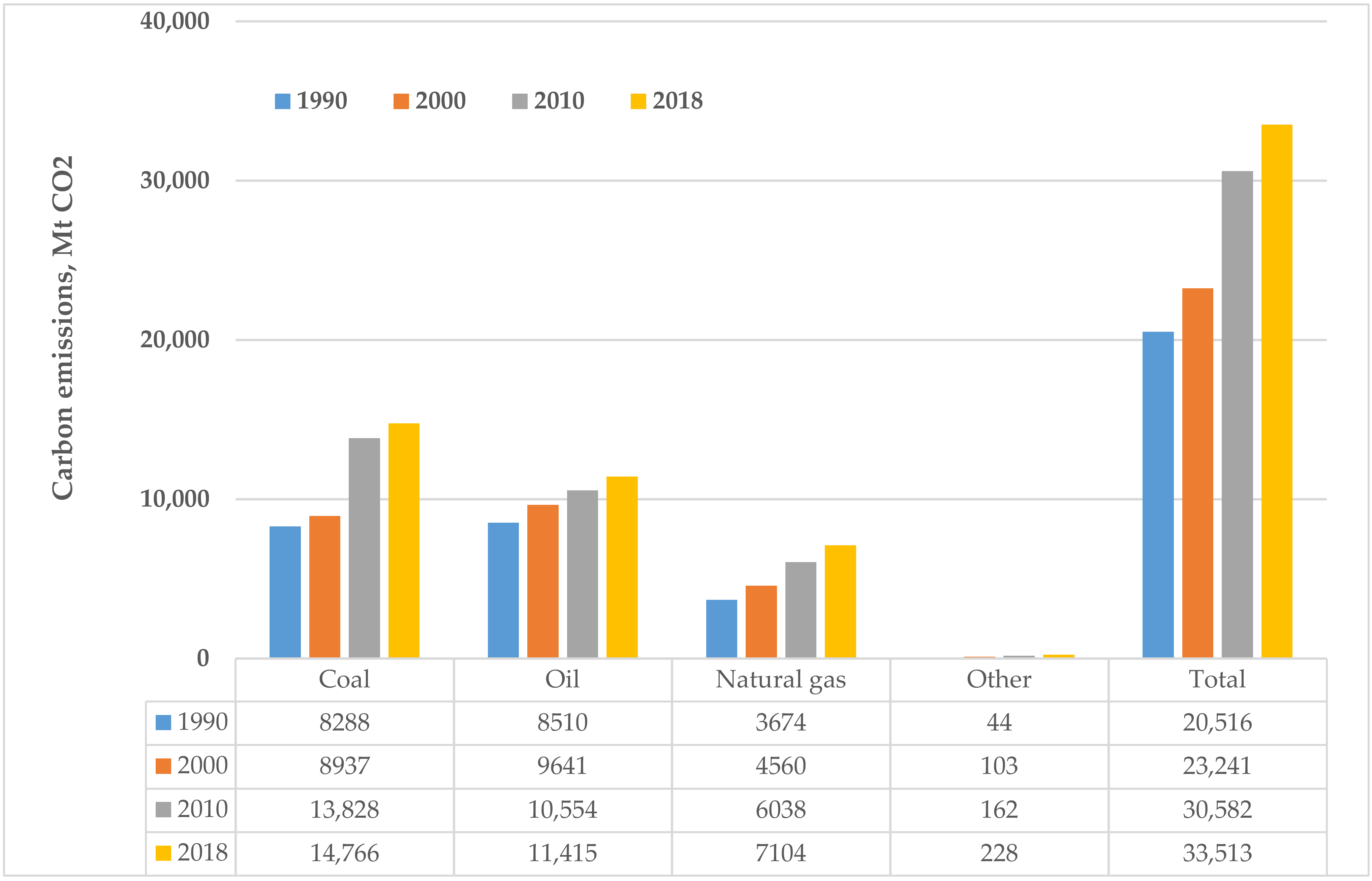
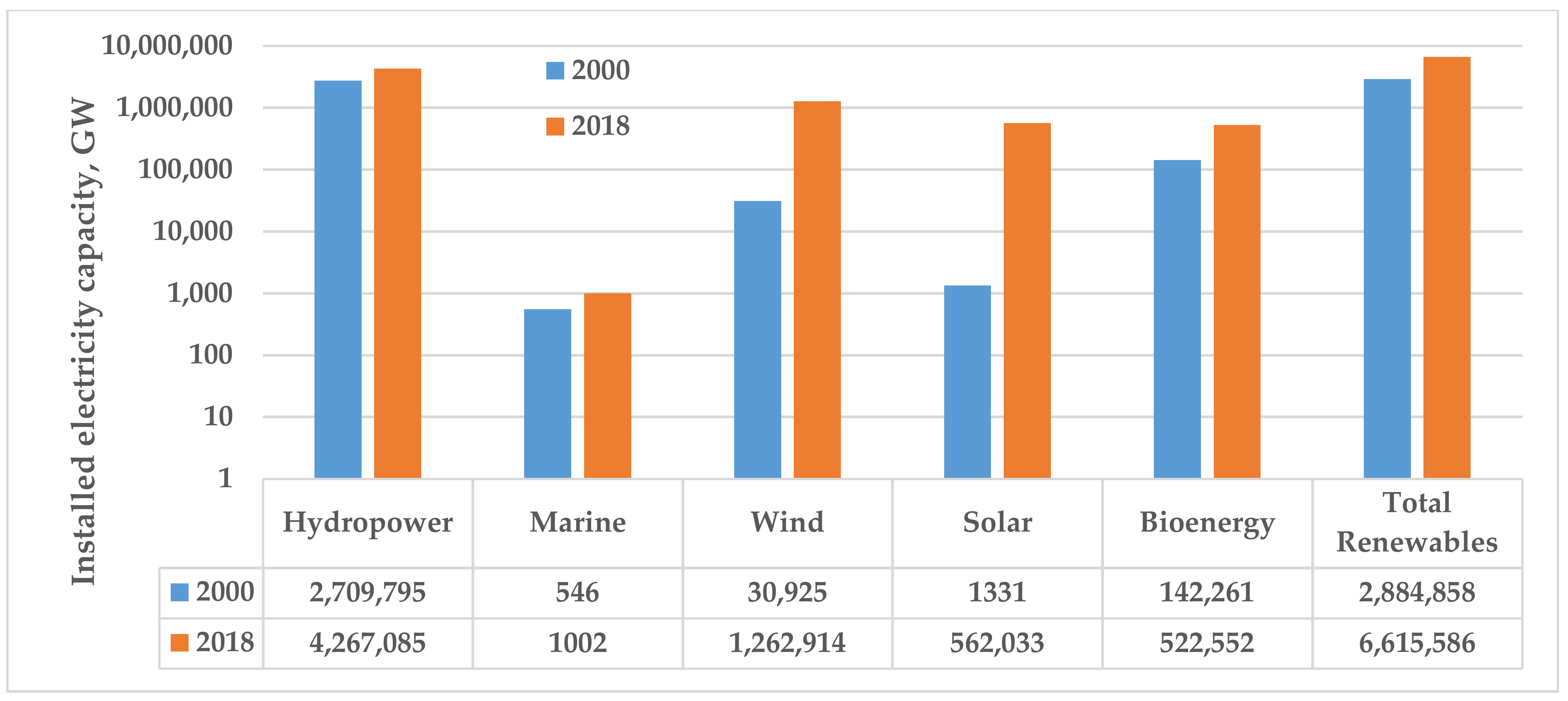
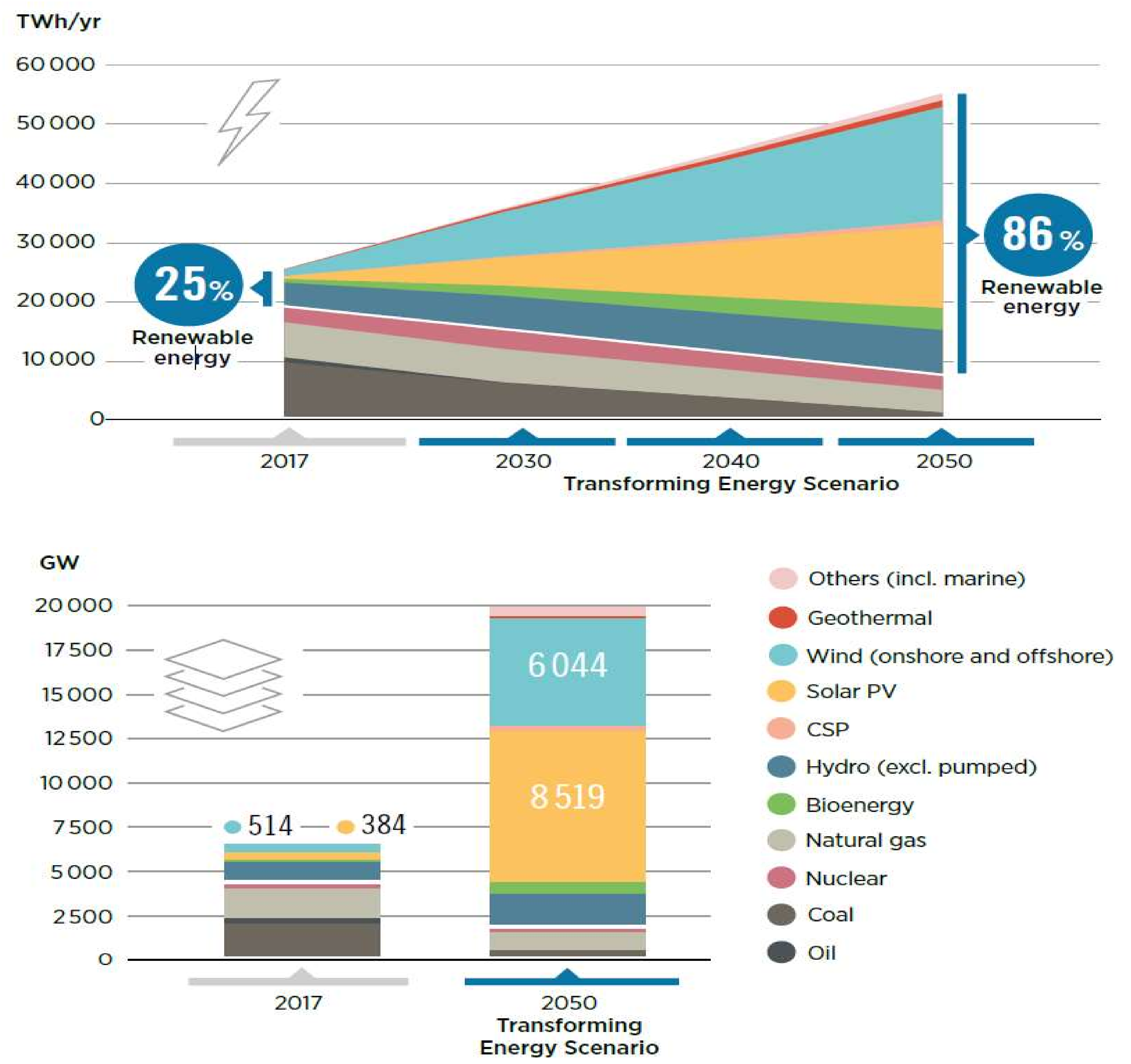
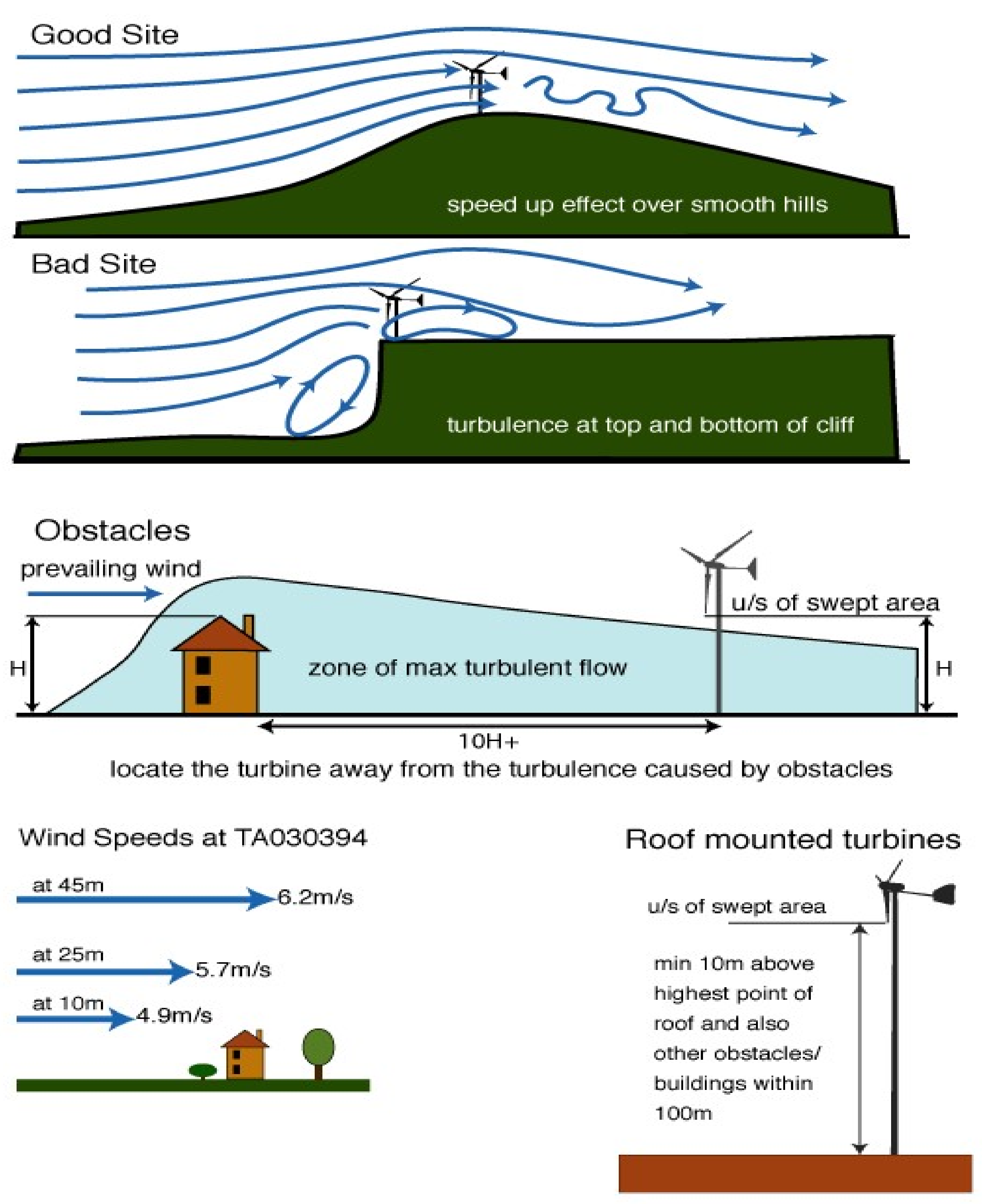
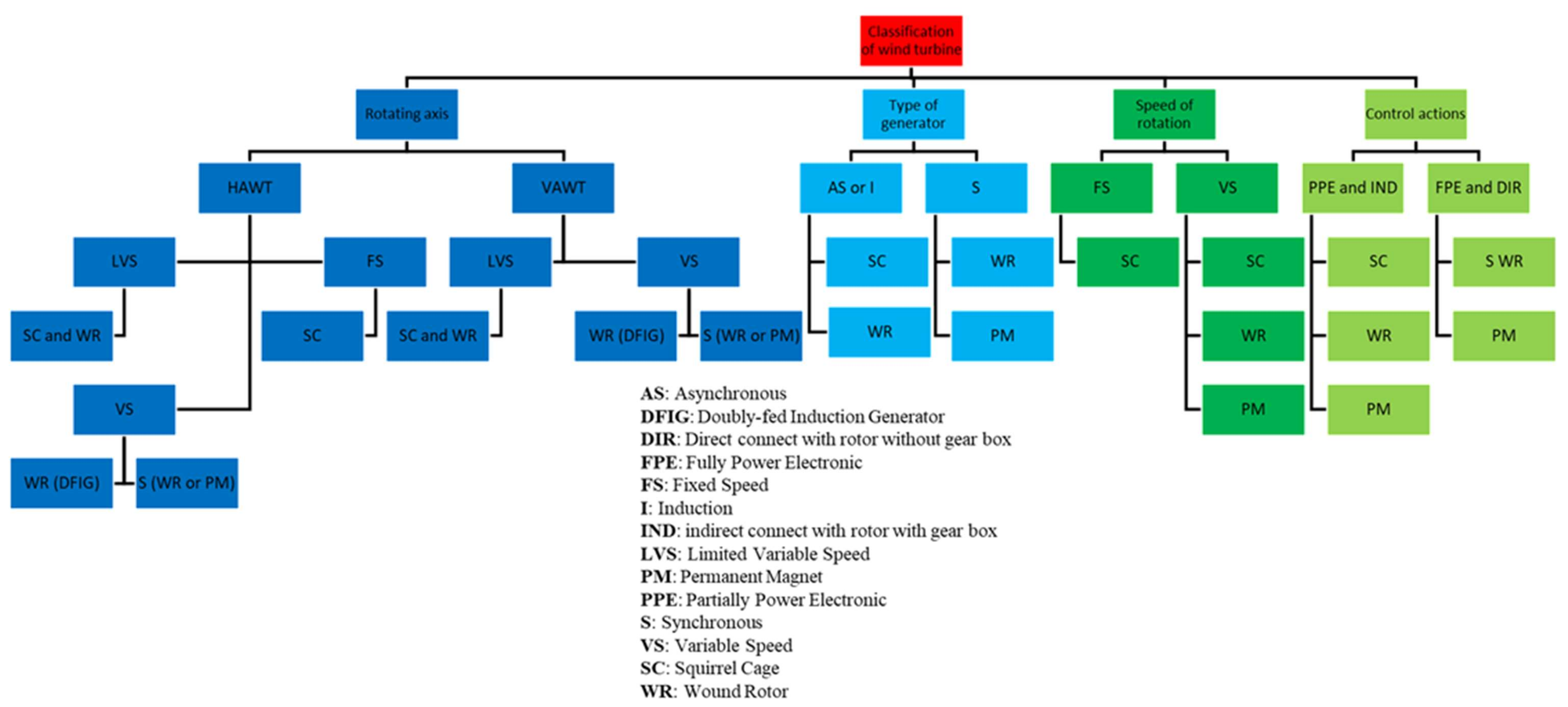
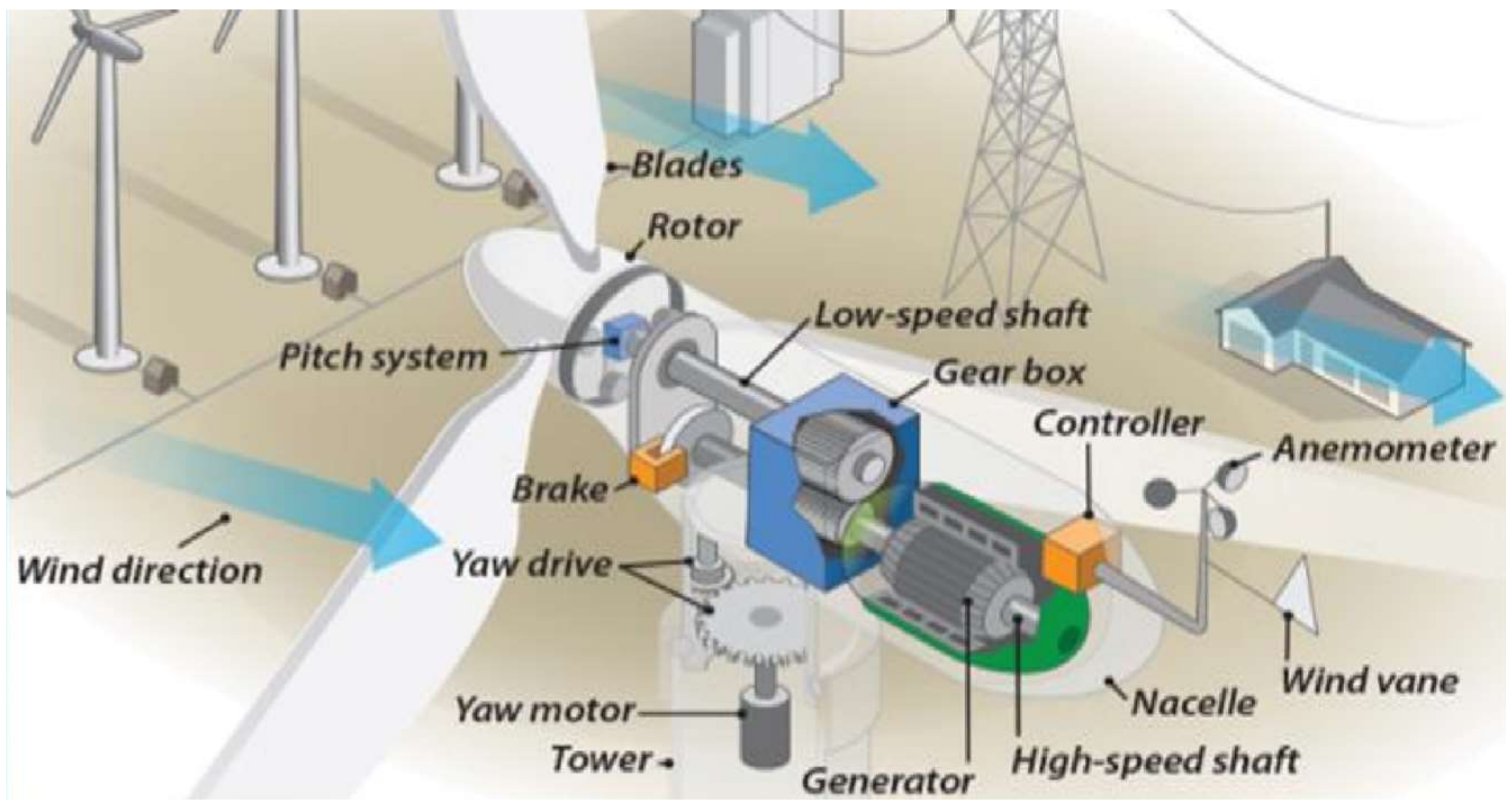
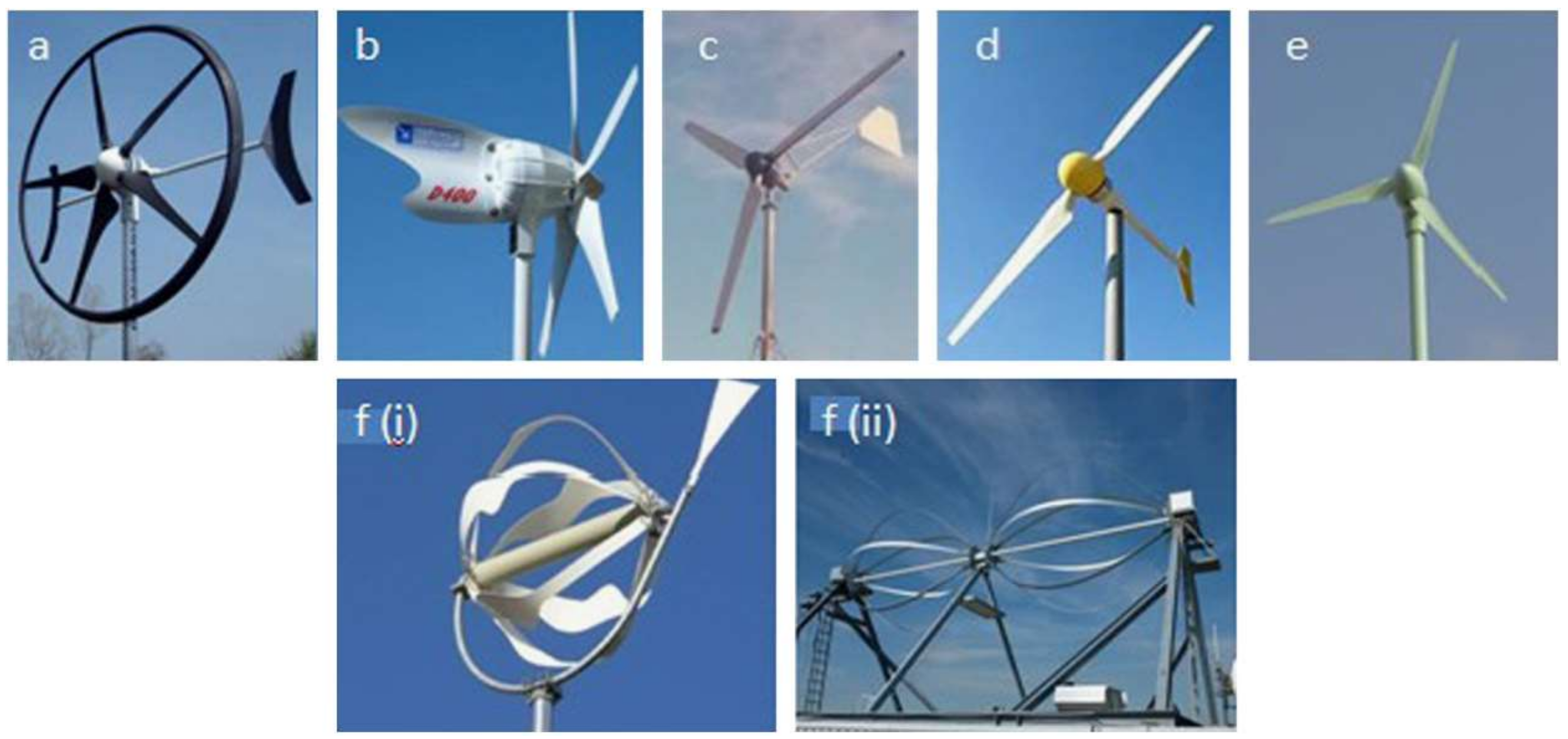
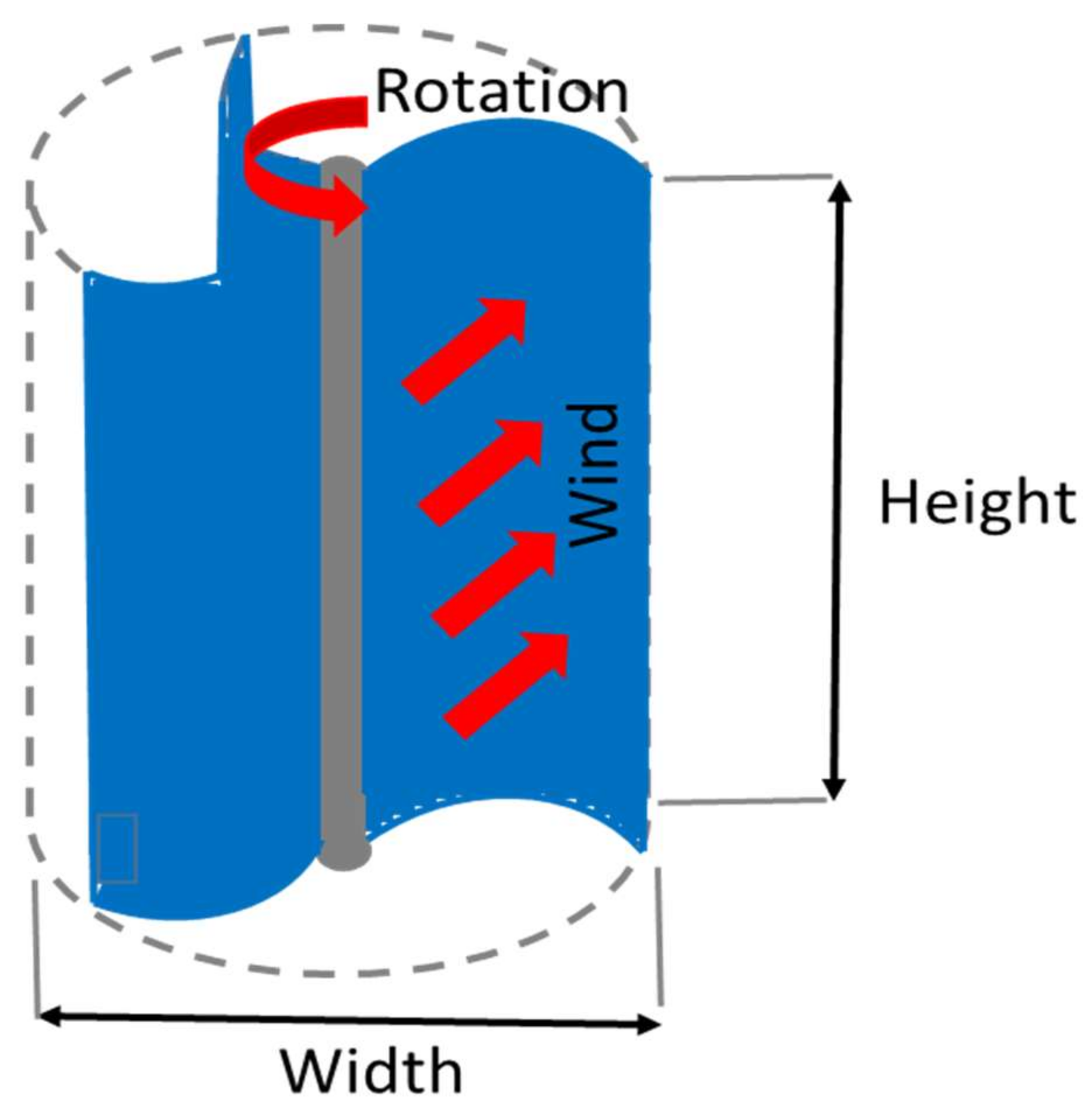
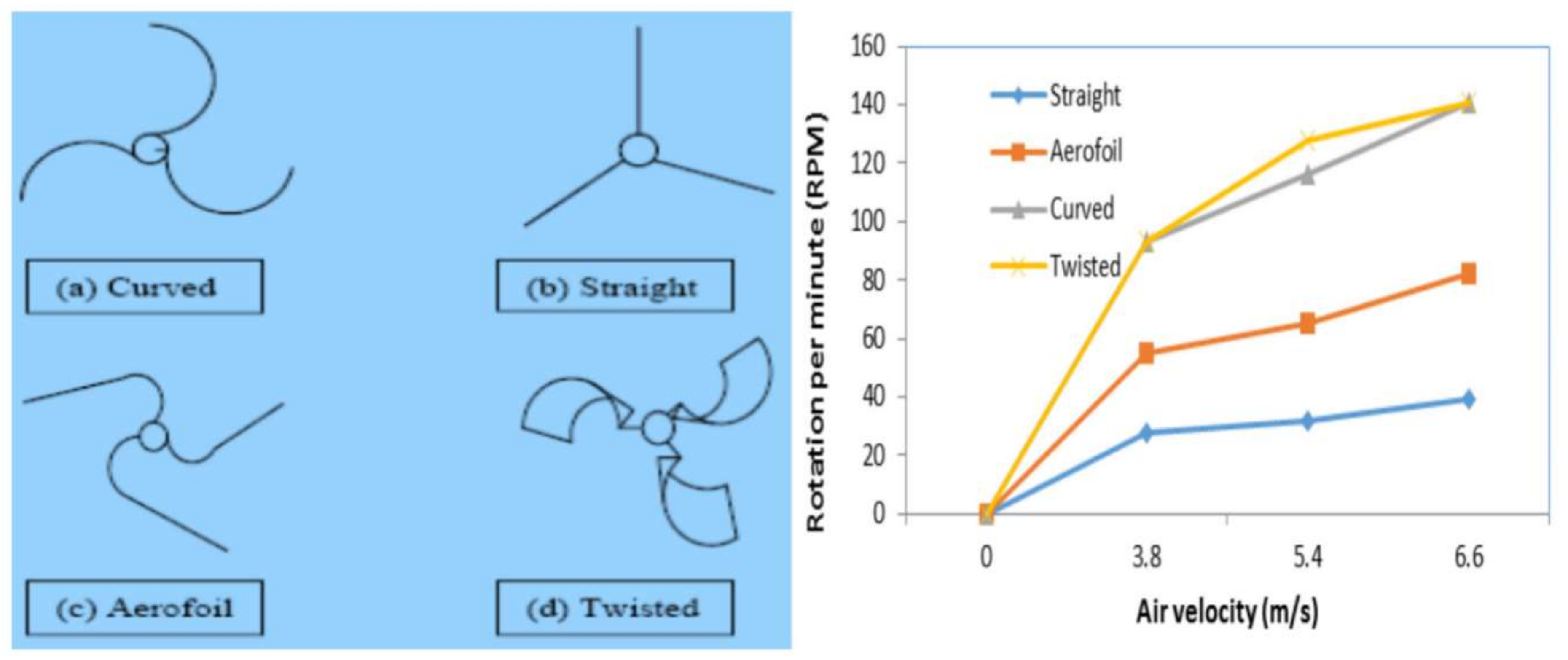
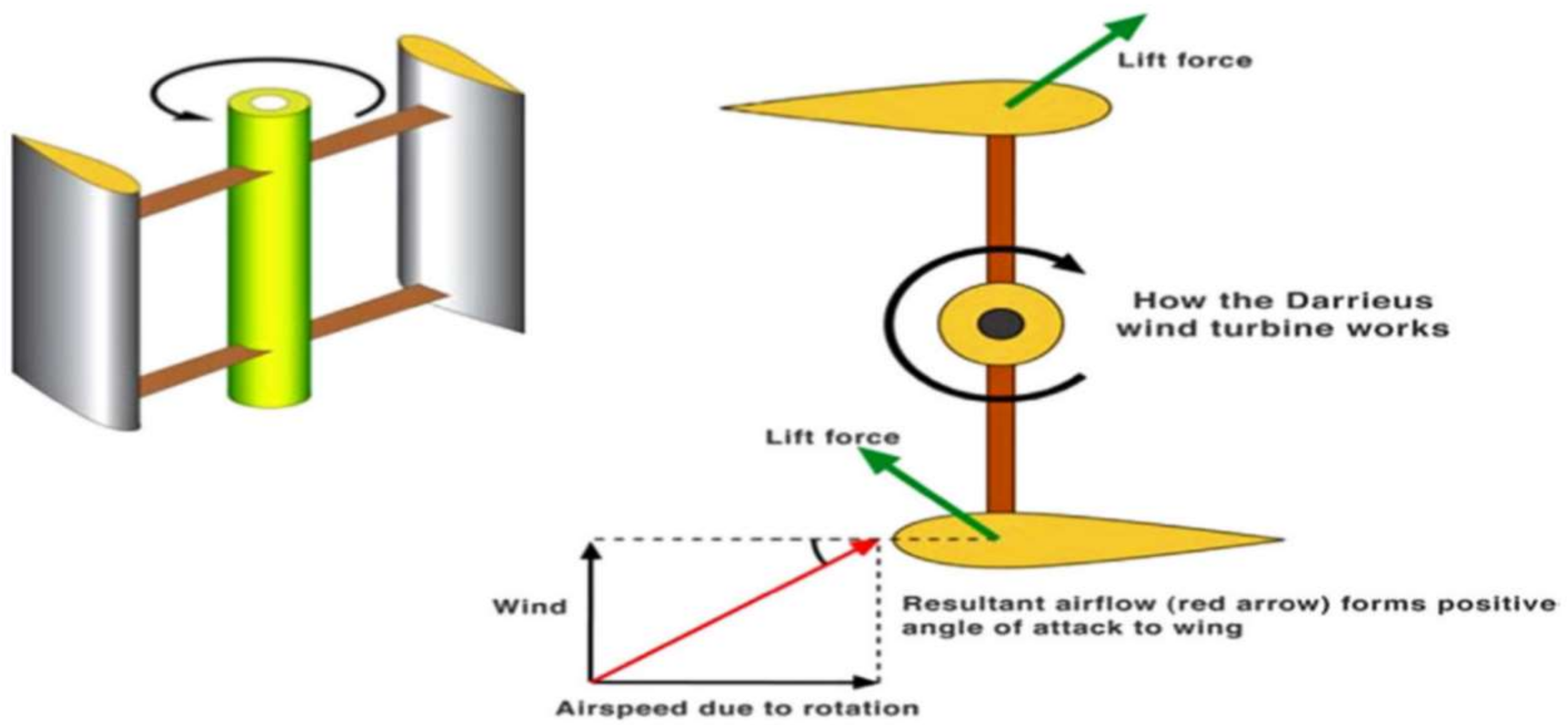
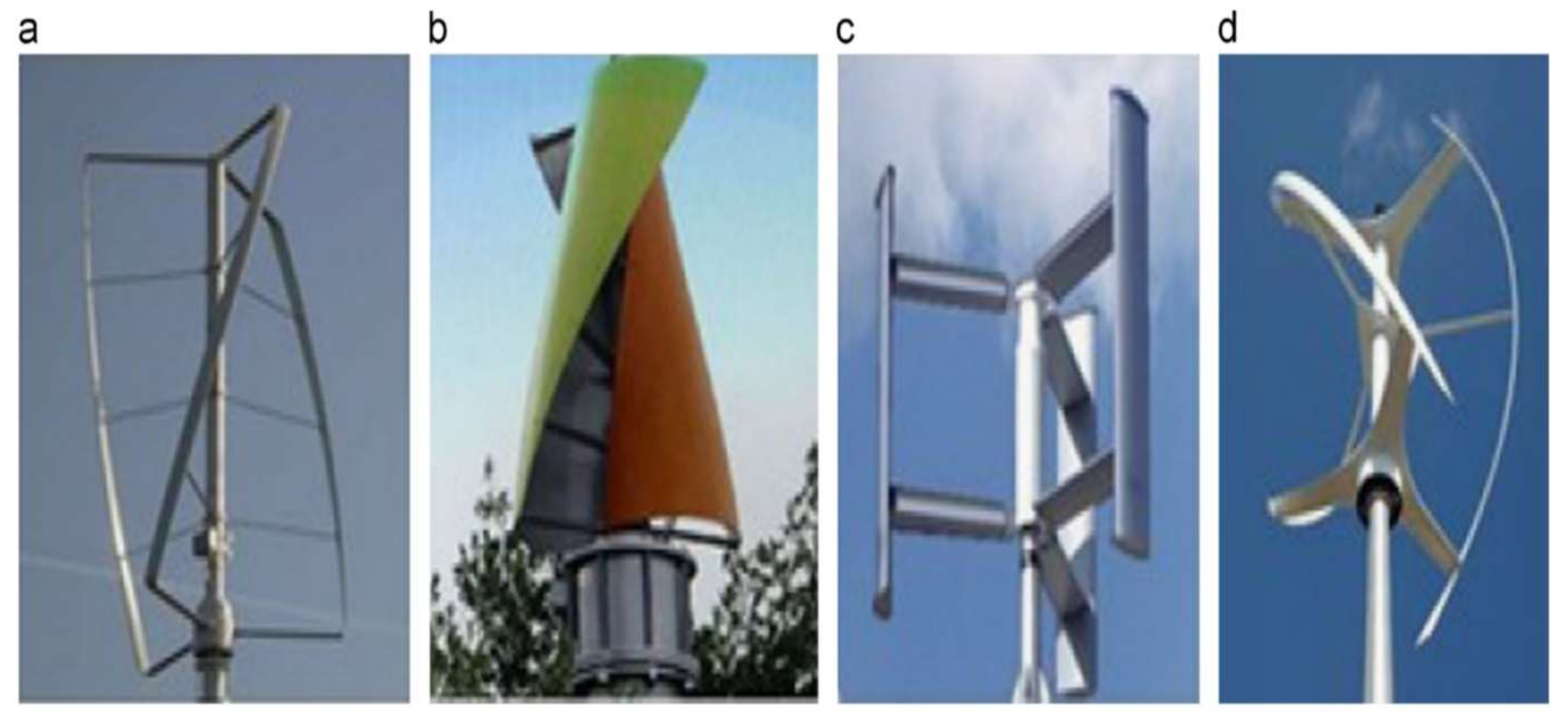

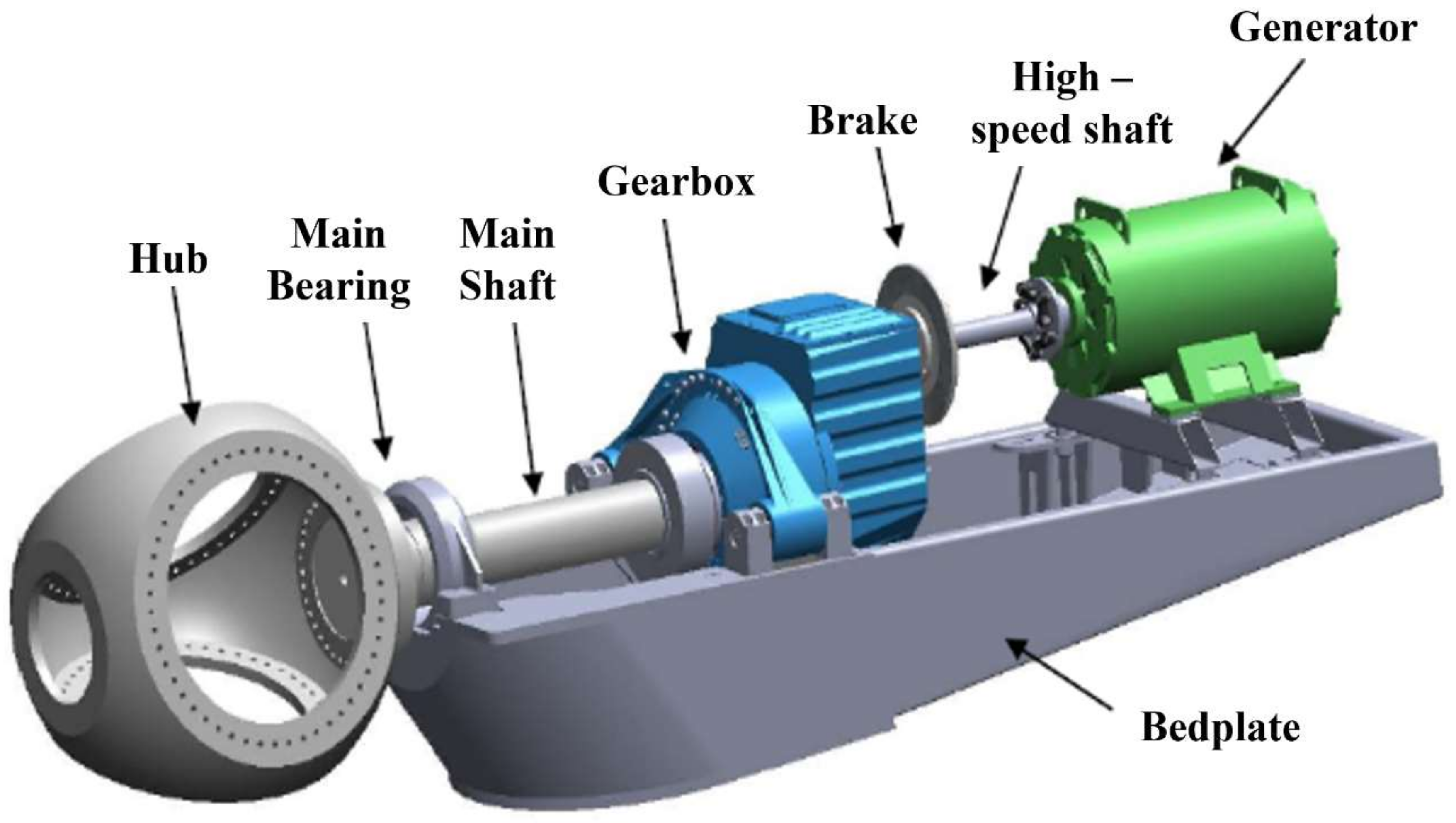

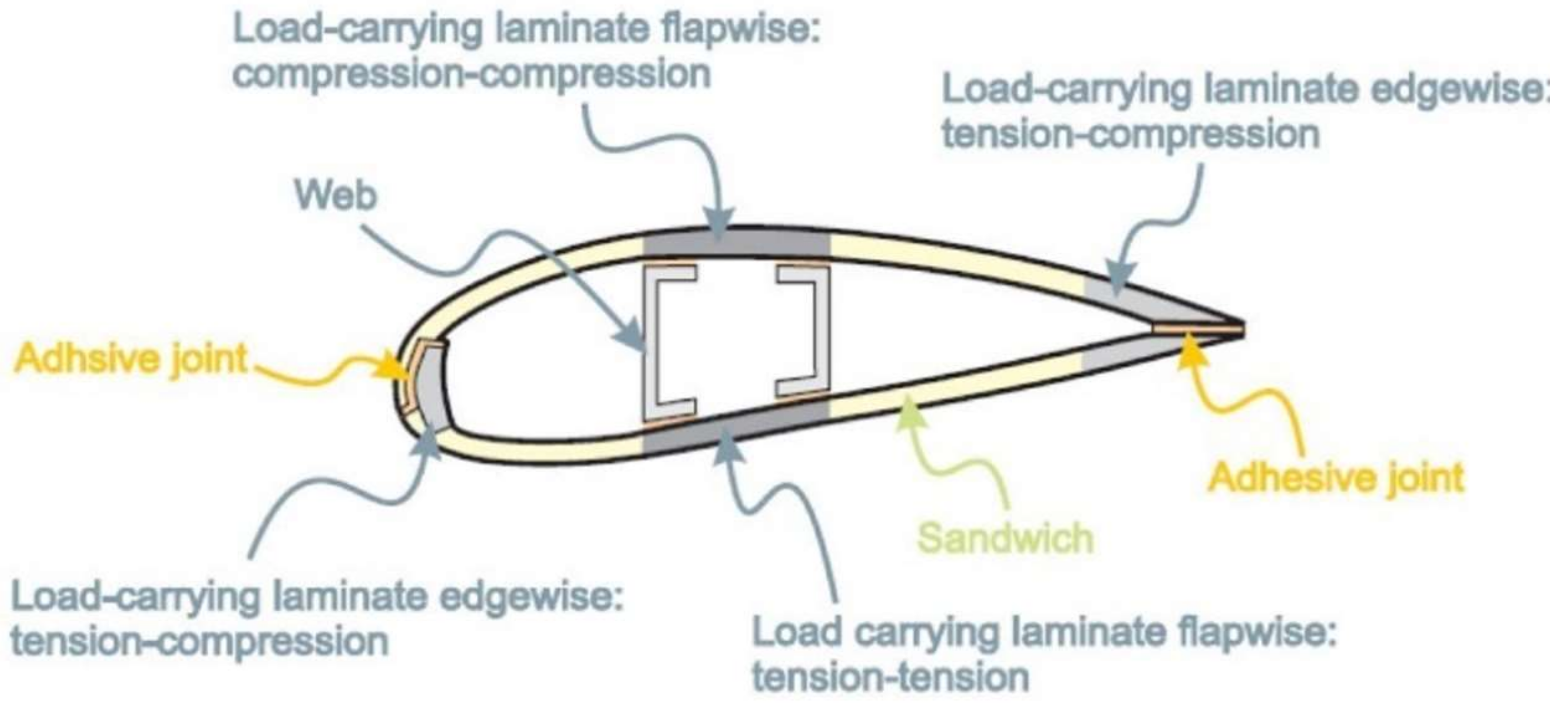
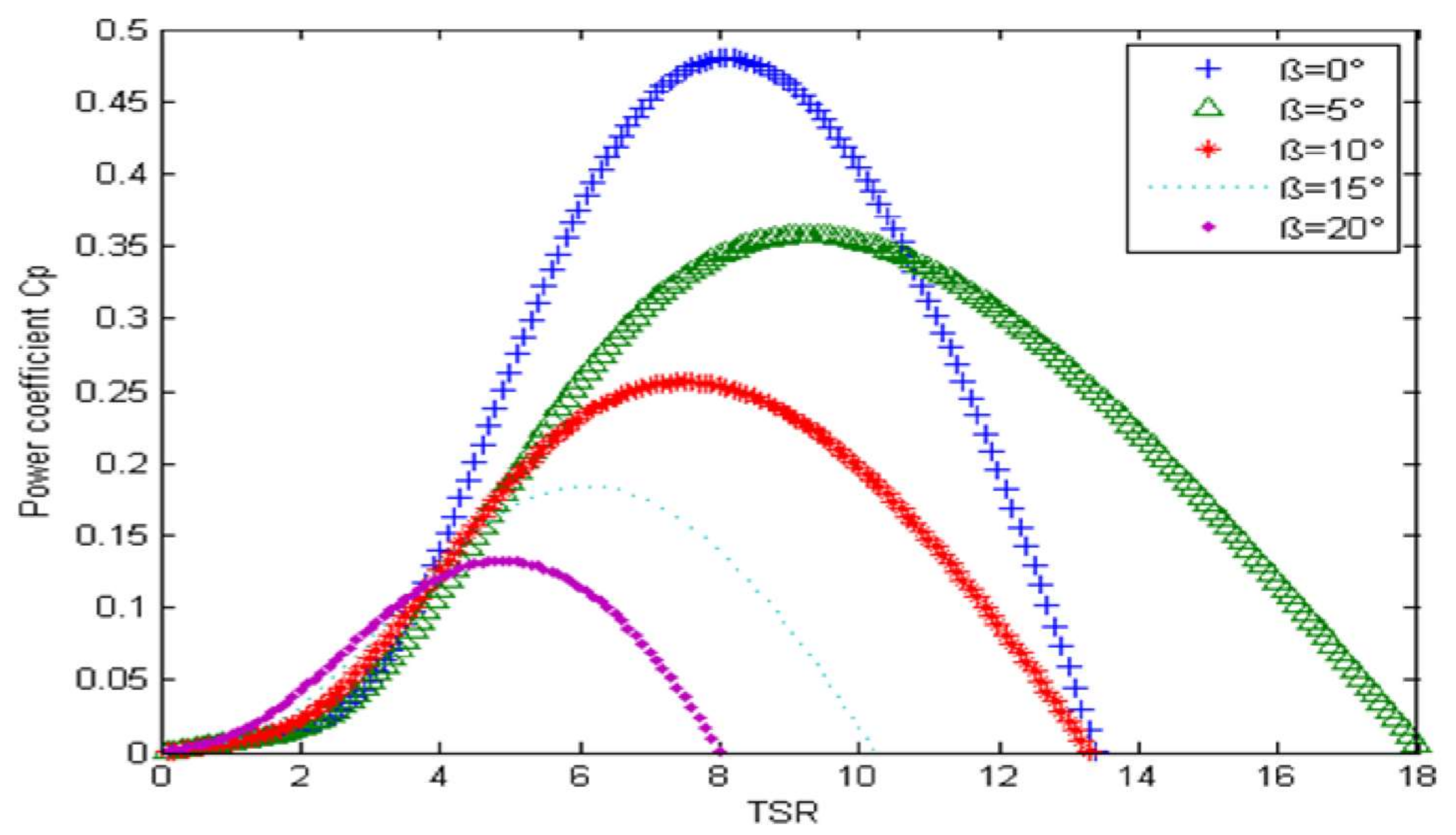
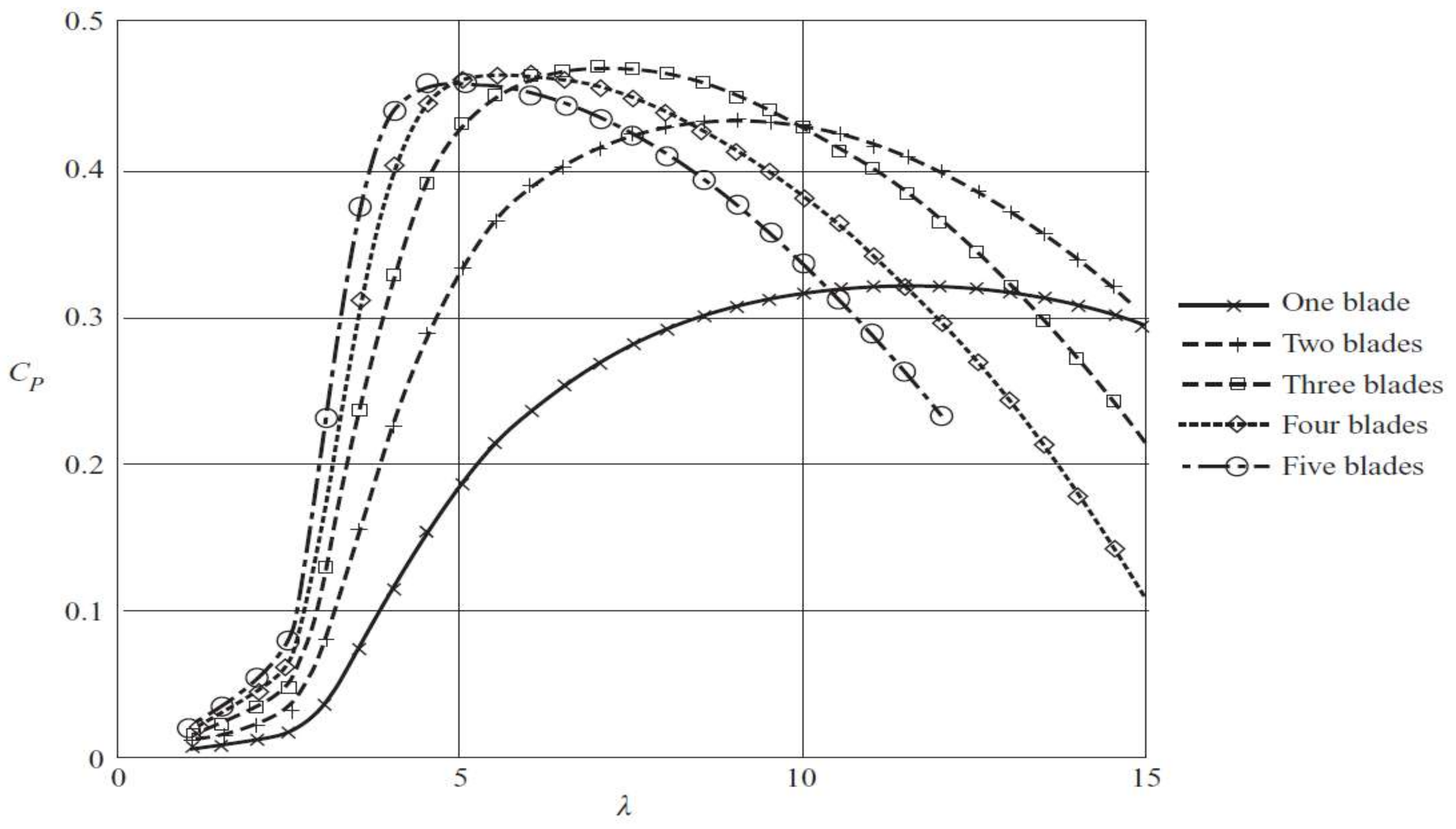
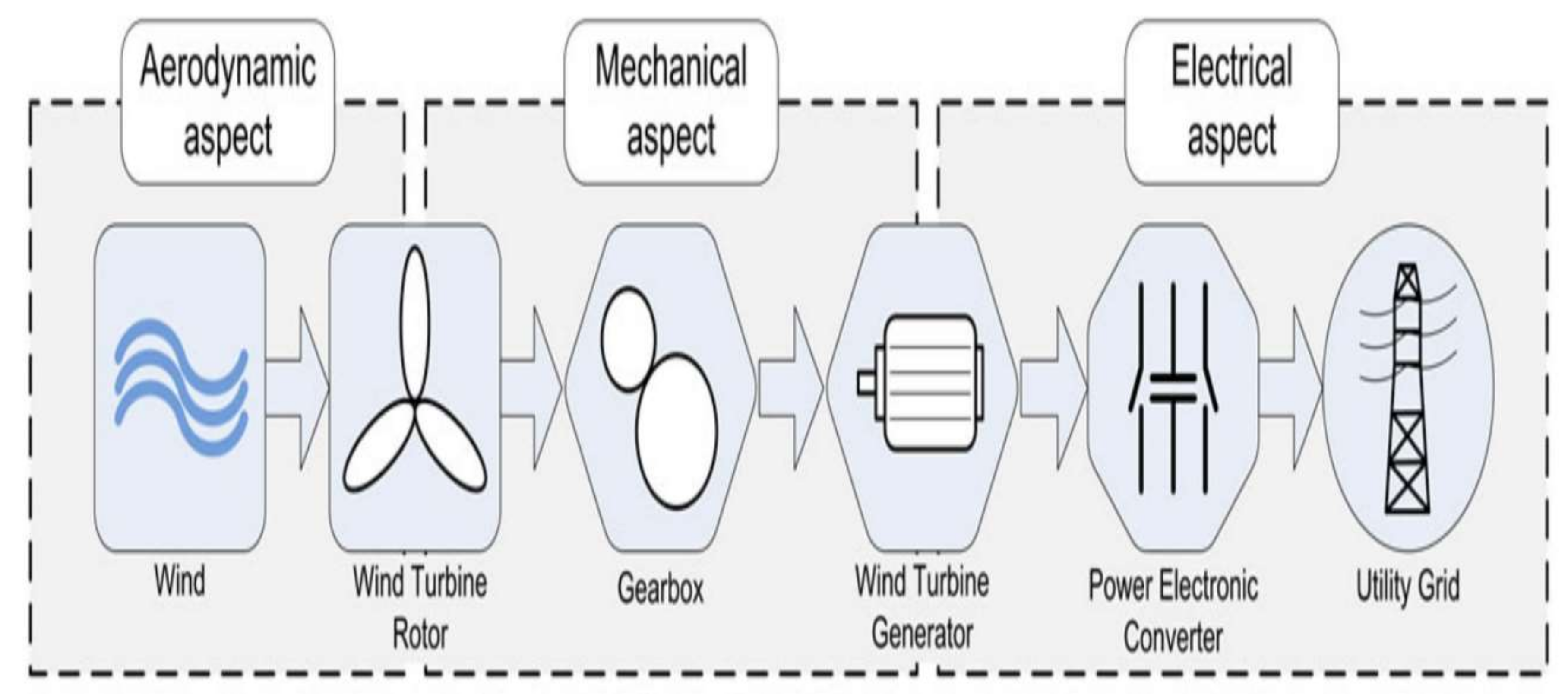
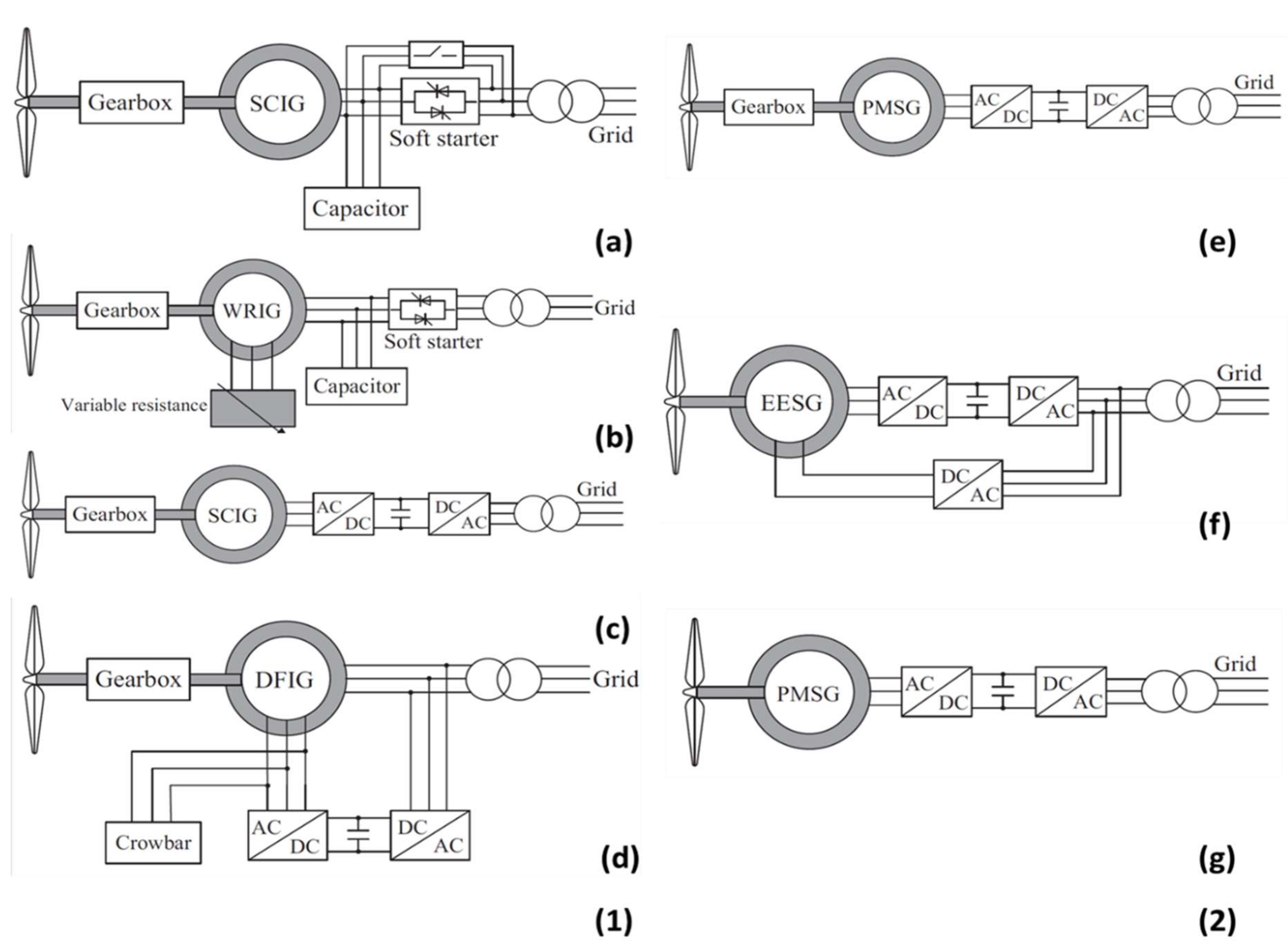
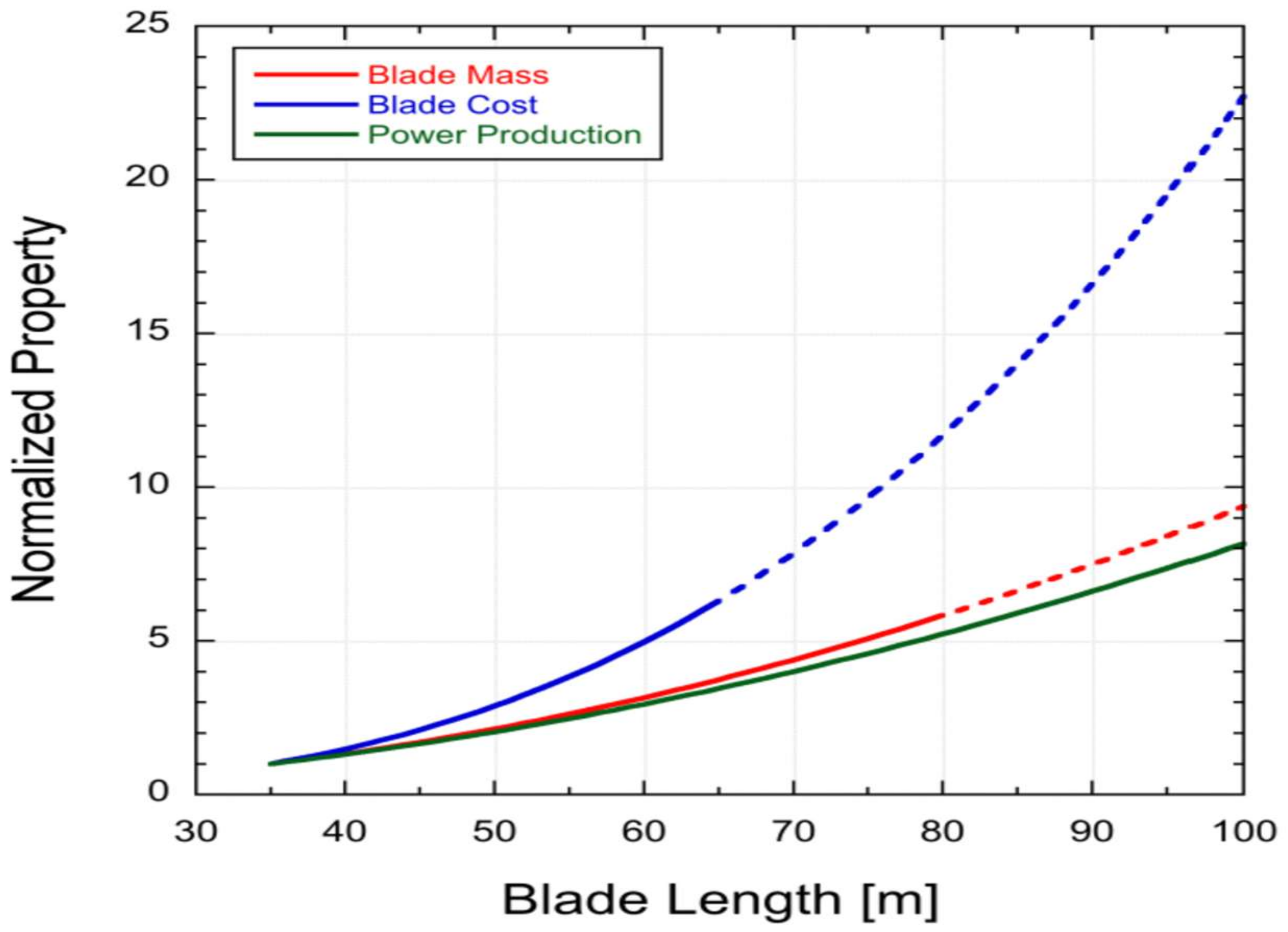
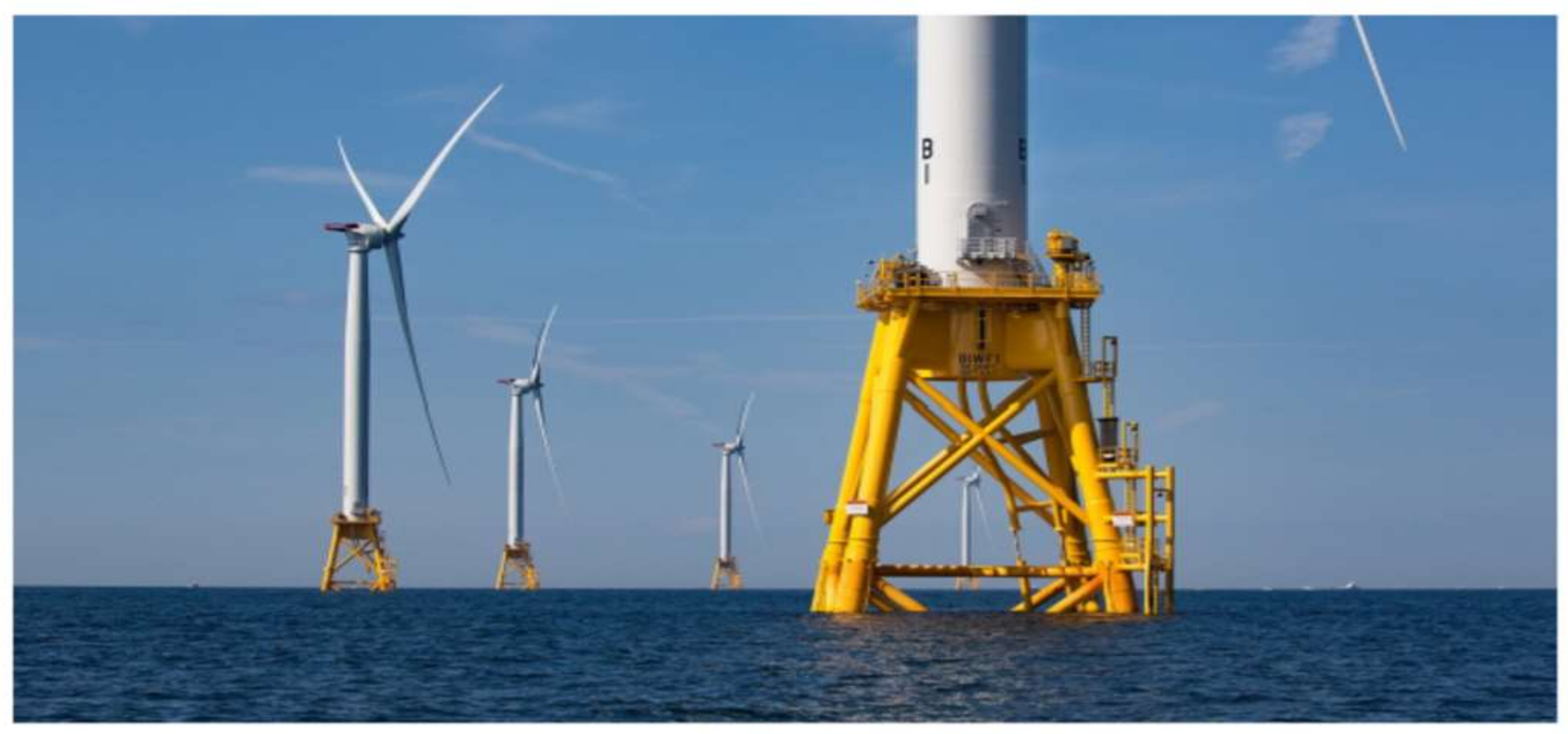
| HAWT Type | Characteristics | Application |
|---|---|---|
| Swift | Tend to have smaller blades with a ring around them to limit any form of vibration and noise. | Suitable for cities and urban environments. |
| Eclectic | suitable for low wind velocity, hence generating energy even at unfavorable locations. | Low weight, making it easy for them to be attached to structures in urban areas. |
| Fortis Montana | No noise during operation even at 50 m closer to the turbine. | Due to the compact size, they are useful for generating electricity for domestic purposes. |
| Scirocco | Use similar characteristics of large turbines like varying pitch blades and the application of optimized two-rotor blades during their operation. | Cheap and can produce a high amount of energy even at low wind velocity. |
| Tulipo | Fixed blades with less periodic maintenance requirements. Suitable for low wind speed. Low vibration or noise produced. | Higher electrical energy can be generated even at low wind speed. |
Publisher’s Note: MDPI stays neutral with regard to jurisdictional claims in published maps and institutional affiliations. |
© 2021 by the authors. Licensee MDPI, Basel, Switzerland. This article is an open access article distributed under the terms and conditions of the Creative Commons Attribution (CC BY) license (https://creativecommons.org/licenses/by/4.0/).
Share and Cite
Olabi, A.G.; Wilberforce, T.; Elsaid, K.; Salameh, T.; Sayed, E.T.; Husain, K.S.; Abdelkareem, M.A. Selection Guidelines for Wind Energy Technologies. Energies 2021, 14, 3244. https://doi.org/10.3390/en14113244
Olabi AG, Wilberforce T, Elsaid K, Salameh T, Sayed ET, Husain KS, Abdelkareem MA. Selection Guidelines for Wind Energy Technologies. Energies. 2021; 14(11):3244. https://doi.org/10.3390/en14113244
Chicago/Turabian StyleOlabi, A. G., Tabbi Wilberforce, Khaled Elsaid, Tareq Salameh, Enas Taha Sayed, Khaled Saleh Husain, and Mohammad Ali Abdelkareem. 2021. "Selection Guidelines for Wind Energy Technologies" Energies 14, no. 11: 3244. https://doi.org/10.3390/en14113244
APA StyleOlabi, A. G., Wilberforce, T., Elsaid, K., Salameh, T., Sayed, E. T., Husain, K. S., & Abdelkareem, M. A. (2021). Selection Guidelines for Wind Energy Technologies. Energies, 14(11), 3244. https://doi.org/10.3390/en14113244








